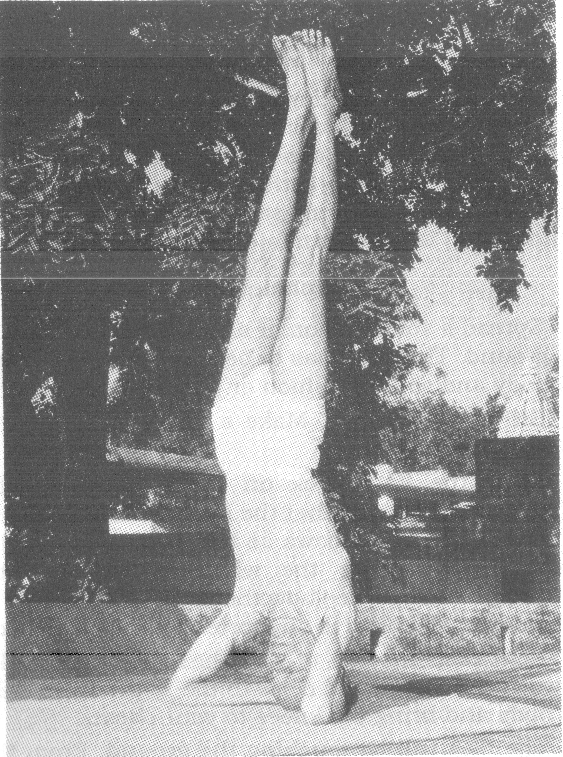
Index
Drink Water through the Nose for Health
Yogic Exercises for an All-round Development of Body-Course I
Yogic Exercises for an All-round
Hatha Yoga by the saintly author Sri Swami Sivanandaji Maharaj is a companion volume to the book Yoga Asanas by him. Besides Yogic exercises, it deals with Pranayamas, Mudras, Bandhas and Shat Karmas in a more detailed and comprehensive manner. It also presents Mula Bandha in Yoga' and `Nava Chakra Viveka.'
Hatha Yoga as delineated and described here is material drawn mainly from the three popular treatises: Siva Samhita, Gheranda Samhita and Hatha Yoga Pradeepika.
By the practice of Hatha Yoga, you can possess a healthy body and mind and attain spiritual experiences also. Swami Sivanandaji Maharaj was never tired of proclaiming: "I like to serve you all. I like to make you all happy. I like to help you in destroying the ignorance and in attaining the goal of life—God-realisation."
Hatha Yoga is one of the gem among the vast literature of the author. We are happy to present this invaluable treasure to the readers after a lapse of sixty years and hope that it will be well received by the readers.
—THE DIVINE LIFE SOCIETY
IMORTANCE OF HATHA YOGA
आलोच सर्वशास्त्राणि विचारये च पुनः पुनः I
या इदमेक सुनिष्पन योगशास्त्र पर मत्तम II
(शिव संहिता)
Having studied all the Sastras and having pondered over them well, again and again, this Yoga Sastra has been found to be the supreme doctrine.
-Siva Samhita
नास्ति मायासंम पाशो नास्ति योगातपर बलं I
नास्ति ज्ञानतपरो बंधुनार्हकरातपरो रिपु II
(घेरण्डसंहिता)
There are no fetters like those of Maya (illusion), no strength like that which comes from Yoga, there is no friend higher than Jnana, and no greater enemy than Ahamkara (egoism).
-Gheranda Samhita
सत्य बहुमत धावते राजयोगमजानतम I
हठप्रदीपिका धत्ते स्वआत्माराम कृपाकर II
To those who wander in the darkness of the conflicting sects unable to obtain Raja Yoga, the most merciful Swatmarama Yogi offers the light of Hatha Vidya.
आशेस्तपताना समसरायमठो हठ I
आशेशयोगयुक्तनामाधारकमठो हठ II
The Hatha Vidya is a monastery for those scorched by the three Taapaas (pains). To all those engaged in the practice of Yoga. Hath Yoga is like the Tortoise that supports the world.
युवाव्रदोतीव्रदो वा व्याधितो दुर्बलोपीबा I
अभ्यासतिसदिमाप्नोति सर्वयोगेसवन्द्रित II
(हठयोगप्रदीपिका)
Any person who actively practises Yoga becomes a Siddha, be he young, old or even even very old, sickly or weak.
-Hatha Yoga Pradipika
The whole universe from the mightiest sun to the tiniest atom is controlled by law. There is perfect order everywhere. The sun performs its duties quite regularly. It rises at proper time and sets at the proper time. The stars and planets revolve in an orderly manner. They are governed by laws. There are laws in mental plane. There are laws of physics, of astronomy, of mathematics. There are laws of hygiene and health which govern our own being. In the vast universe man only breaks and violates all rules and laws. He is the single example of lawlessness and discord. He wilfully disregards the laws of health, leads a life of dissipation and then wonders why he suffers from disease and disharmony. He deliberately ignores the rules of hygiene and right living and then weeps when he is ailing from an incurable dire malady.
What is that precious thing which makes life worth living? It is health. "Sariramadhyam khalu dharma sadhanam"—Body is indeed the foremost essential thing for the attainment of the goal of human existence. Charak Maharishi says in his Samhita: "Dharmartha kama mokshanam arogyam moolamuttamam, Yogastasya apahartara sreyaso jivitayacha"—Health is the best cause of virtue, wealth, desire and emancipation, and is the blessed-ness of life. Diseases are the destroyers of health. The laws of the preservation of health should receive your foremost consideration. The laws of health are the laws of nature. These should not be violated with impunity. Those who neglect these laws become victims to incurable diseases and drag a cheerless existence.
Health is wealth, Health is a covetable possession indeed. Health is a valuable asset for one and all. You should have physical as well as mental health. If you do not possess good health you cannot prosper in any walk of life.
Health is that state in which a man sleeps well, digests his food well, is quite at ease, is free from any sort of disease or uneasiness. When you are in a state of perfect health all the organs, viz., heart, lungs, brain, kidneys, liver, intestines work in perfect harmony and concord and discharge their functions satisfactorily. The pulse rate and the rate of respiration are in perfect order. The bodily temperature is normal. Your bowels move very freely every day. A healthy man smiles and laughs. He is cheerful and happy. He discharges his daily duties with ease and comfort. A healthy man is capable of doing work for a long time without getting fatigued. He possesses highest mental and physical efficiency.
A healthy man need not be necessarily strong and a strong man need not be healthy. A very strong man may suffer from diseases. A healthy and strong man becomes a centre of great attraction. He radiates health and strength to all persons with whom he comes in contact.
Strength and size are not always the same. Either a thin or wiry or a heavy-built man may be strong. Besides muscular strength, you must have nerve strength as well. There are different kinds of strength. Some can lift heavy weights. Some can run a long distance quickly. Some can jump higher. Some can bear heat and cold. Some can fast for days together.
Some can bear any amount of pain. Some can bear insult or injury. Some can stop a car and break chains. Some can swim for a long distance. Many have great physical strength but they do not have mental strength. One harsh word can upset their balance of mind. Some people who have immense physical strength cannot bear the pain of an acute disease. They cry like children when they suffer from any disease. They have no mental strength. Some are afraid of public criticisms even though they are physically strong.
He who possesses physical, mental, moral and spiritual strength is an ideal man. Moral strength is superior to physical strength. It is difficult to poesess moral strength. Spiritual power is the highest power on earth. A saint or a Yogi who possesses spiritual strength can move the whole world. He is a dynamic personality. The strength of Gandhiji is moral strength. He has gained the strength by the practice of Ahimsa, Satya and Brahmacharya. Gandhiji has no physical strength. He has mental and moral strength. A powerful spiritual soul may dwell in a thin wiry body.
The world needs good healthy mothers, healthy and strong boys and girls. What do you find in these days in India? India, the land which produced Bhishma, Bhima, Arjuna, Drona, Aswatthama, Kripa, Parasurama and countless chivalrous warriors, the soil which contained numberless Rajput Chiefs of undaunted intrepidity, unparalleled chivalry and matchless strength abounds now with effeminate impotent weaklings. Children beget children. The laws of health are ignored and neglected. The nation is dying and suffering. The world requires numberless brave, moral Adhyatamic soldiers who are equipped with five virtues, viz., Ahimsa, Satya, Asteya, Brahmacharya and Aparigraha. Those who possess health and strength, those who are endowed with the above five virtues, those who have knowledge of the Self can secure real freedom for the world.
Good health is the greatest asset for you. Without good health you can hardly expect success in any walk of life. Even for spiritual pursuits good health is the prerequisite. Without good health you cannot penetrate into the hidden depths of the vast ocean of life within and attain the final beatitude of life. Without good health you cannot wage war with the turbulent senses and boisterous mind.
By drinking pure water, by eating pure and wholesome food, by observing the laws of health and hygiene, by taking regular exercise and cold baths in the morning, by practising Japa and meditation, by right living, right thinking, right action, right conduct, by observing Brahmacharya, by living in open air and sunshine for some time daily, you can have wonderful health, vigour and vitality.
Sattvic Ahara or good wholesome food rich in vitamins or a well-balanced diet, systematic practice of Yogic Exercises, right living, right thinking and simple living are the important requisites for the preservation of health and attainment of high standard of vigour and vitality. These are the sublime principles on which the Rishis and Yogins of yore lived a long, peaceful life. These are the important methods on which they based the system of Yoga to achieve perfection in health of body and mind. These are the support on which the sinking nation must fall back if it wishes to regain her lost glory and splendour.
Regular practice of Yogic exercises even for fifteen minutes a day will keep you quite fit and make you hale and hearty. You will have abundant energy, muscular strength and nerve power, a charming personality and longevity.
There are nowadays many systems of physical exercises. Among all the systems, Hatha Yoga practised and prescribed by the ancient Rishis and sages stand unrivalled and unique. It is the most perfect system. Brain, muscles, nerves, organs, tissues are toned and energised. All chronic diseases are rooted out. By practice of exercises of Hatha Yoga, you can possess a healthy body and mind and attain spiritual experiences also.
The subject Hatha Yoga is a systematic course of exercises. It deals with Shat Karmas, Asanas, Pranayams, Mudras, Bandhas, and exercises on concentration and meditation.
Asanas pertain to the physical body. They render the body firm and steady and eradicate physical ailments. Bandhas pertain to the Prana. That which binds is a Bandha. They do not allow the Prana to move upwards and the Apana to move downwards. They bind and unite the Prana with the Apana and send the united Prana-apana along the Sushumna Nadi. Mudras concern the mind. They represent seals. Mudra means a seal. They seal the mind with the soul or Atman. They do not allow the mind to wander outside towards objects. They direct the externalising mind towards Atman in the chambers of the heart and fix it there. A combination of all exercises is needed.
The first Chapter of this book deals with the important exercises of Asanas or postures. For health and strength I have prescribed about 20 exercises.
They are divided into 8 groups according to the nature of Asanas and the benefits realised from each. Group 8 gives the technique of four Asanas that are highly suitable for meditative purposes. The second Chapter describes the exercises on Pranayama. Practice of Pranayama exercises improves the lungs, blood circulation and purifies the Nadis and nerves.
In the third Chapter you will find a description of a number of Mudras and Bandhas. At the end I have given important articles on Kundalini, the methods to awaken it, Concentration, Health and Longevity. I have also given in this book a set of exercises prescribed for daily practice. From each group you will have to select 1 or 2 exercises according to your temperament, capacity and time at your disposal. Even if you select one exercise from each group and devote at least 15 minutes daily, you can have an all-round development of body.
May you all attain good health, long life and a high standard of vigour, vitality, through the practice of Yogic Exercises and the blessings of Rishis!
-SWAMI SIVANANDA
O Mother Divine, O Serpentine Kundalini Shakti!
Indweller of our hearts!
Thou sleepest in the Muladhar
With three and a half coils,
Thou art Sakar and Nirakar,
Thou art Sagun and Nirgun,
Thou art the Source and support,
Thou dwellest in electrons.
Vedas sing of Thee
Sages contemplate on Thee,
Yogis meditate on Thee,
Bhaktas worship Thee.
Thou art unfathomable!
Thou art incomprehensible!
Thou art immovable!
Thou art unthinkable!
Let our eyes behold Thee,
Let our tongues praise Thee,
Let our hands work for Thee,
Let our minds be fixed on Thee.
Let me dwell in Sahasrara,
Let my Sushumna be opened,
Let my Kundalini be awakened,
Let me taste the nectar of Hatha Yoga.
Let me attain Samadhi,
Let my Prana be in unison with Apana,
Let me have Kevala Kumbhak,
And let me become one with Thee.
O Brother! attain good health.
Without health how can you live?
Without health how can you earn?
Without health how can you succeed?
Possess the health through Hatha,
Unite the Ha with Tha,
Unite the moon with the sun,
Unite the Prana with Apana,
Drink the nectar at Sahasrara,
And live in the Immortal abode.
Hatha and Raja are inseparable,
Where Hatha ends Raja Yoga begins.
Hatha Yoga prepares you
For Nirvikalpa Samadhi.
No Hatha Yoga, no success,
No Hatha Yoga, no Samadhi.
No Hatha Yoga, no health.
No Hatha Yoga, no Veerya.
No Hatha Yoga, no beauty.
No Hatha Yoga, no long life.
Salute Ganapathi before you begin.
Practise Sirsh, the King of Asanas
And remove all diseases.
Develop thyroid through Sarvang
And digest food through Paschimottan.
Mayur can digest even poison.
Ardha Matsyendra can make the spine elastic.
Bhujang, Salab and Dhanur
Can give you a good motion
And eradicate constipation.
Preserve Veerya through Sirsh-Sarvang
And avoid wet-dreams.
Relax the muscles in Savasana
Combine forward backward bending exercises
Never neglect the spinal twist
If you wish all-round development.
The fat in the belly the Paschimottan reduces.
The spine the Hala makes supple and elastic.
Drowsiness the Vajra surely will drive.
The effect of Sarvang the Matsya will add.
Pranayam removes all diseases
And the gastric fire it increases.
A little Kumbhak will give you longevity
Strength, vigour, vim and vitality
And awaken Kundalini in Muladhara.
Sitali can cool your brain and body
And purify the blood.
Bhastrika will remove
Asthma and consumption.
Bandha Traya can make you beautiful.
Suitable is morning for the practice.
Do Asanas to begin with and then Pranayama.
Spend fifteen minutes a day
For practice of Asana and Pranayama.
This will suffice to keep you healthy.
Be regular in your practice.
Drink a little milk in the end.
Wait for one hour for bath.
Be moderate in eating and sleeping.
Hot curries, onions, and garlic abandon,
With empty stomach practise Yogic Exercises.
CONTENTS
|
Publishers' Note |
8 |
|
Introduction |
11 |
|
Prayer |
17 |
|
Glory of Hatha Yoga |
18 |
CHAPTER I
Asanas
|
Group 1—Topsy-turvy: |
|
|
Sirshasana |
27 |
|
Oordhva Padmasana |
32 |
|
Sarvangasana |
32 |
|
Group 2—Forward Bending: |
|
|
Paschimottanasana |
36 |
|
Halasana |
38 |
|
Padahasthasana |
40 |
|
Group 3—Backward Bending: |
|
|
Matsyasana |
42 |
|
Bhujangasana |
45 |
|
Dhanurasana |
47 |
|
Chakrasana |
49 |
|
Supta Vajrasana |
53 |
|
Group 4—Sideway Bending: |
|
|
Trikonasana |
55 |
|
Tadasana |
57 |
|
Group 5—Spinal Twist: |
|
|
Ardha-Matsyendrasana |
59 |
|
Group 6—Abdominal Exercises: |
|
|
Salabhasana |
61 |
|
Mayurasana |
63 |
|
Lolasana |
65 |
|
Group 7—Science of Relaxation: |
|
|
Savasana |
69 |
|
Group 8—Meditative Poses: |
|
|
Padmasana |
73 |
|
Utthita Padmasana |
76 |
|
Siddhasana |
77 |
|
Swastikasana |
77 |
|
Sukhasana |
80 |
|
Instructions on Asanas |
80 |
|
Vrikshasana |
86 |
|
Parvatasana |
86 |
CHAPTER II
Pranayama
|
What is Pranayama? |
87 |
|
Sukha Purvak |
93 |
|
Surya Bheda |
97 |
|
Ujjayi |
98 |
|
Sitkari |
98 |
|
Seetali |
100 |
|
Bhastrika |
100 |
|
Bhramari |
103 |
|
Murchha |
103 |
|
Plavini |
104 |
|
Kevala Kumbhak |
104 |
CHAPTER III
Mudras and Bandhas
|
Maha Mudra |
106 |
|
Tadan Kriya |
106 |
|
Maha Bandha |
107 |
|
Maha Vedha |
107 |
|
Yoni Mudra |
108 |
|
Yoga Mudra |
108 |
|
Khechari Mudra |
110 |
|
Mulabandha |
11 |
|
Jalandara Bandha |
11 |
|
Uddiyana Bandha |
11 |
|
Bandha Traya |
113 |
|
Vipareetakarani Mudra |
114 |
|
Shakti Chalan Mudra |
115 |
|
Aswini Mudra |
115 |
|
Tadagi Mudra |
116 |
|
Bhuchari Mudra |
116 |
|
Agochari Mudra |
116 |
|
Shambhavi Mudra |
116 |
|
Manduki Mudra |
117 |
|
Bhujangini Mudra |
117 |
|
Matangini Mudra |
117 |
|
Vajroli Mudra |
117 |
CHAPTER IV
Shatkarmas
|
Dhauti |
119 |
|
Vastra Dhauti |
119 |
|
Vatsara Dhauti |
120 |
|
Bahishkrita Dhauti |
120 |
|
Agnisara Dhauti |
120 |
|
Vamana Dhauti |
121 |
|
Basti |
121 |
|
Sthala Basti |
121 |
|
Jala Basti |
121 |
|
Neti |
122 |
|
Nauli |
122 |
|
Tratak |
125 |
|
Kapalabhati |
125 |
CHAPTER V
Rambles in Yoga
|
Kundalini |
127 |
|
How to Awaken the Kundalini |
132 |
|
Chakras |
136 |
|
Health and Longevity |
137 |
|
Concentration |
142 |
|
Yogic Alphabets |
144 |
|
Mulabandha in Yoga |
146 |
|
Nava Chakra Viveka |
149 |
|
Drink Water through the Nose for Health |
150 |
APPENDIX
|
Yogic Exercises for an All-round |
155 |
|
Development of Body-Course I |
|
|
Yogic Exercises for an All-round |
156 |
|
Development of Body-Course II |
157 |
|
Special Instructions |
|
ASANAS
Group 1—Topsy-turvy Poses
Sirshasana is the king of all Asanas. By practice of this Asana, you can get the maximum physical and spiritual benefits. In Sanskrit "Sirsha" means 'head.' In this Asana as the practitioner has to stand on his head, it is called as Sirshasana. Kapalyasana (Kapala means head) is another name for this Asana.
Technique
Spread a soft cushion or a four-folded blanket on the ground. The skull has to bear the whole weight of the body and so the cushion or blanket is necessary.
Sit on your knees. Make a finger-lock by inter-weaving the fingers.
Place the finger-lock on the ground over the blanket in such a way that the locked hand serve as a vertex and the two elbows as the base to enable the forearms to balance the whole body. From the illustration you can see how the finger-lock is kept on the ground. The head is supported by the finger-lock.
Now keep the top of your head on the blanket between the hands and close to the finger-lock. Raise the body and bring the knees to your chest.
The toes will be touching the ground. From this position slowly try to remove the toes a little up from the ground. In 2 or 3 attempts you will learn the art of balancing the body. Then slowly raise the legs still higher up till the body becomes erect. Stand on this Asana for a few seconds to begin with and gradually increase the period to half an hour. Then bring down the legs very slowly.
PICTURE: SIRSHASANA

You can successfully learn the Asana with the help of a wall. Keep the finger-lock and head near the wall and throw away your legs on the wall. Try to remove the legs from the wall. By this method also you can learn to balance the body. Or you can ask your friend to catch hold of your legs. He can occasionally leave his hands to see if you are able to remain steady.
When you remain in the Asanas breathe through your nose and never through the mouth. For a few days you will find it difficult to breathe through the nose freely. Then you will find it easy.
If you find it difficult, to balance the body on the finger-lock, you can keep the palms on the ground. After some practice you can take to finger-lock method. After the exercise is over, stand erect for a few seconds and take some rest, before you begin the next exercise. This will harmonise the circulation of blood. There are people who can stand on this Asana for 2 to 3 hours at one stretch. In summer do not practise this for a very long time. You can repeat the Mantra of your Ishta Devata when you stand on the Asana.
Benefits
The whole body is inverted in this pose. Owing to gravitation, the arch of the arota, the common carotids, the innominate and the subclavian are flooded with rich arterial blood and in this Asana alone the brain can draw a rich supply of pure blood. The 12 pairs of cranial nerves, spinal cord, 31 pairs of spinal nerves and sympathetic system get sufficient nourishment. All the defects of the nerves, eyes, nose, throat and ears are completely removed by the practice of this Asana. It is a powerful nervine tonic. The whole nervous system is nourished and toned. All the venous blood that has to rise against the gravity is now helped by the force of gravity and so the veins and their valves get ample rest. So this Asana will serve as a cure for Varicose vein.
This is extremely useful in keeping up Brahmacharya. The seminal energy is transmuted into Ojas Shakti. This is called sex-sublimation. Person’s suffer-ing from wet-dreams or Spermatorrhea will derive very great relief. The seminal energy is converted into Ojas Shakti and flows towards the brain for being stored up as spiritual force which is used for contemplative purposes, Dhyana. Great benefit is derived by sitting for meditation after the practice of Sirshasana. In this Asana you can hear Anahata sounds (mystic sound) distinctly.
Sirshasana invigorates, energise's and vivifies. This is a panacea (a cure-all), sovereign specific for all human ailments. It is a powerful blood purifier. It cures all the diseases of the liver, spleen, lungs and genito-urinary system. It cures renal colic, deafness, diabetes, piles, fashionable pyorrhoea, constipation. The digestive power will become keen. This is best suited for all ladies also. Many uterine and ovarian diseases are cured. It is not advisable for ladies to practise this Asana during the monthly periods and pregnancy.
Sterility disappears. Memory increases admirably, Lawyers, occultists and thinkers will find this extremely useful. If you observe the breath you will notice that it becomes finer and finer. This Asana leads to natural Pranayama and help awakening of Kundalini Shakti that lies dormant in the Muladhara Chakra or basal lotus.
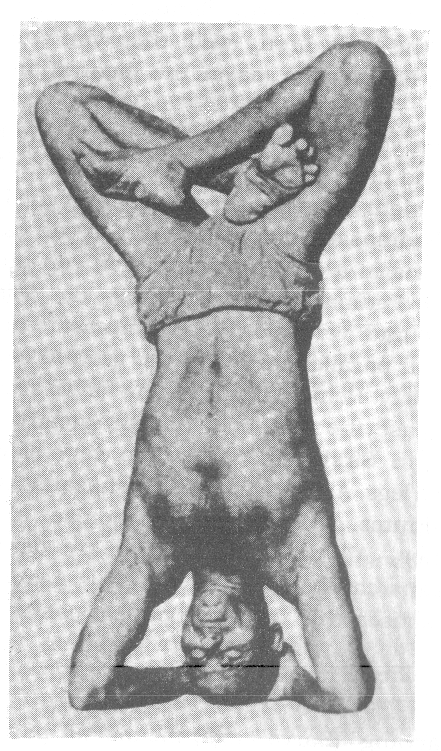
PICTURE: OORDHA PADMASANA
If you can perform Sirshasana perfectly and balance the body pretty well, then you can practise Oordhva Padmasana (as in the illustration on page 31).
When you stand on Sirshasana, slowly bend the left leg and place the foot on the right thigh. Similarly bend the right leg and place the foot over the left thigh. This is Padmasana or foot-lock. If you can easily form Padmasana in a sitting posture, you can attempt for Oordhva Padmasana. You must do this Asana carefully and very slowly. A gymnast who can do balance in parallel bar or on the ground can do this Asana easily. Remain in the Asana for 15 seconds and then release the foot-lock. Remain steady for a few seconds in Sirshasana and then very slowly bring down the legs. As instructed in Sirshasana, stand for a few minutes. This will harmonise the blood circulation. All the benefits that are derived from Sirshasana can be attained from this Asana also. He who practises this will have perfect control over the body.
"Sarvang" (Sarva-anga) means 'all parts.' So the very name suggests that this pose concerns with all the parts of the body. It is one of the unique poses which rejuvenates the whole system.
Technique
Spread a thick blanket on the ground. Lie on the back quite flat. Slowly raise the legs. Lift the trunk, hips and legs quite vertically. Rest the elbows on the ground firmly and support the back with the two hands. Raise the legs till they become quite vertical. Press the chin against the chest. This is chin-lock. While you perform the Asana, the back of the neck, posterior part of the head and shoulders should touch the ground. Breathe slowly and concentrate on thyroid glands which are situated at the neck. Do not allow the body to move to and fro. When the Asana is over, bring the legs down very slowly with elegance. Avoid jerks. Do the Asana very gracefully. In this Asana you stand on the shoulders with the support of the hands and the whole weight of the body is thrown on the shoulders. Immediately after performing the Asana, you will have to do Matsyasana to derive the maximum benefits of Sarvangasana. Remain in the Asana for two minutes and gradually increase the period to 30 minutes.
Benefits
Just as Sirshasana is intended to tone up the whole nervous system, this easy and wonderful Asana is intended to promote thyroids and through it the whole body and its functions. Thyroid is the most important gland of the endocrine system. In this Asana the thyroid gland gets a rich supply of blood. Healthy thyroid means healthy function of the circulatory, respiratory, and all systems of the body.
This Asana is a good substitute for modern thyroid treatment. It cures the dreadful leprosy. The patient will have to live on milk during the whole period of treatment. Milk helps the thyroid to secrete its juice in sufficient quantity to help the economy of nature in its restorative function and regeneration. If the patient takes sun-bath morning and evening, his recovery will be hastened.
PICTURE: SARVANGASANA
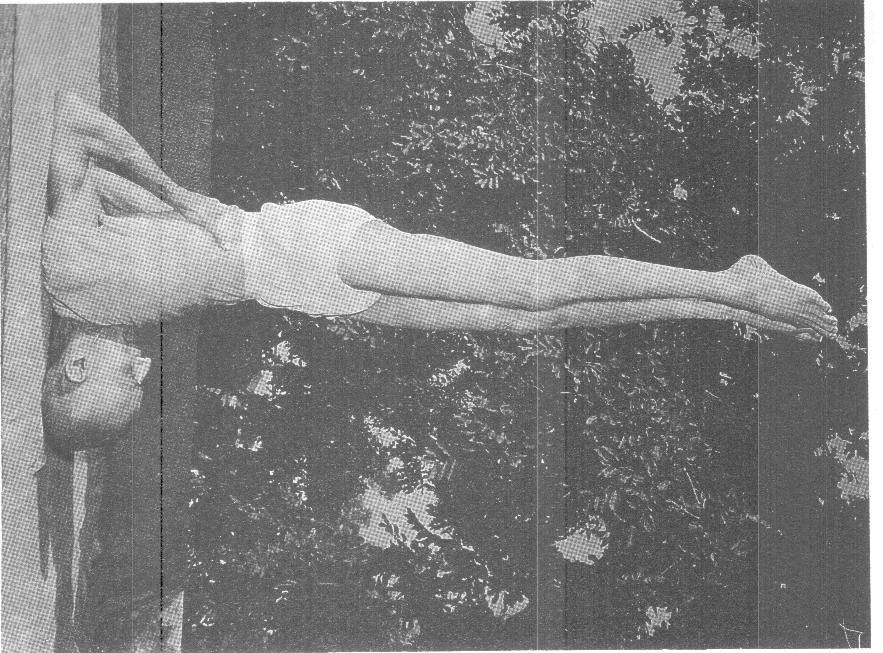
This Asana destroys the ravages of old age and keeps a man young always. It checks wet-dreams effectively. It removes dyspepsia, constipation, appendicitis, other gastro-intestinal disorders and varicose vein. It supplies a large quantity of blood to the spinal roots of nerves. This Asana centralises the blood in the spinal column and nourishes it beautifully. In this Asana the spinal roots draw sufficient supply of blood. It keeps the spine quite elastic. Elasticity of the spine means everlasting youth. It prevents the bone from early ossification (hardening). Sarvangasana awakens Kundalini and augments the digestive power.
As soon as you come down from the Asana it braces you up and gives you a new vigorous, fine, healthy tone. It is an ideal "pick-me-up". Many have reported to me the wonderful, mysterious, beneficial results of this Asana. When you have no time to practise a course of Asanas, do this Sarvangasana without fail along with Sirshasana and paschimot-tanasana. It will save your doctor's bills. A course of Sirsho-Sarvanga Asana powerfully rejuvenates and dispenses with monkey gland grafting.
Group 2—Forward Bending
Technique
Lie flat on the back (spine) over the blanket. Keep the legs and thighs fixed on the ground. Stiffen your body. Slowly raise the head and chest and assume the sitting pose. Now exhale and bend the trunk forward till you are able to catch hold of your toes as shown in the illustration. Bend slowly by gradual degrees. You can even bury your face between the knees. Remain in the Asana for 5 seconds and slowly raise the head and body and come to the spine position. Now you can inhale. Repeat this 3 or 4 times.
Those who find it difficult to do full Paschimottanasana, can do half. Keep one leg at the thigh joint and stretch the other. Now bend and catch hold of the toes. Then you can do like this for the other leg also. After some days when the spine becomes more elastic, you can take up the full Paschimot-tanasana.
Benefits
This is an excellent Asana. It Makes the breath, flow through the Brahma Nadi (Sushumna) and rouses the gastric fire (Jatharagni). All the abdominal muscles get vigorously contracted. It reduces fat in the abdomen. This is a specific for corpulence or obesity and for enlargement of spleen and liver. This is a powerful abdominal exercise. This Asana stimulates the abdominal viscera such as kidneys, liver, pancreas. It increases peristalsis of the bowels and relieves constipation. This cures piles and prevents diabetes. This Asana is a good preventive for nocturnal emissions.
PICTURE: PASCHIMOTTANASANA
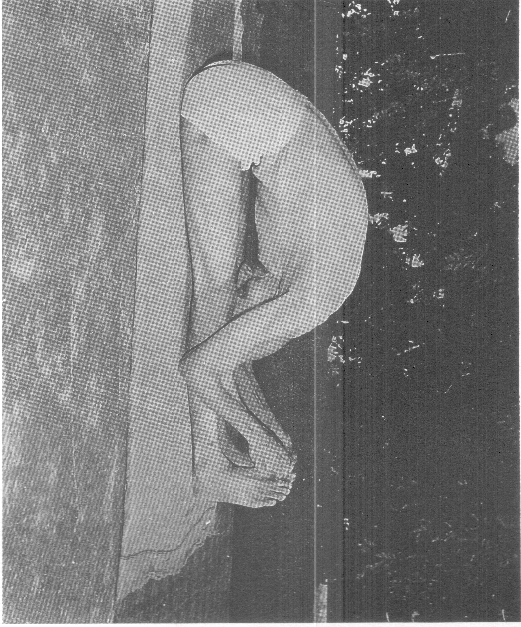
This is a very good Asana for stretching the posterior muscles of the body. The hamstring muscles at the back of the knees get sufficient strength. The epigastric nerves, bladder, prostrate, lumbar and sympathetic nerves are all toned up and kept in sound condition. The spine becomes elastic and thereby perennial youth is established. Halasana and Paschi-mottanasana bend the spine anteriorly in a perfect manner.
When this pose is performed, it gives the exact appearance of a plough. In Sanskrit "Hala" means a `plough.'
Technique
Lie flat on your back on a carpet. Keep the two hands near the thigh, palms facing the ground. Without bending the legs, slowly raise them higher up. Keep the hands quite steady on the ground. Raise the hips and the lumbar part of the back also and bring down the legs to the ground till the toes touch the ground beyond the head. Keep the knees quite straight and close together. The legs and thighs must be in one straight line. Press the chin against the chest. Breathe slowly through the nose. Remain in the Asana for two minutes. Then slowly raise the legs and bring to the original position of lying on the ground flat.
There is another variety in this Asana. When the toes reach the ground, remove the hands and catch hold of the toes. This is also a better variety. Or you can keep the hands as shown in the Illustration. The pose can be repeated 3 or 4 times with advantage. For attaining the spiritual benefits, the pose should be maintained for a long time at a stretch.
PICTURE: HALASANA
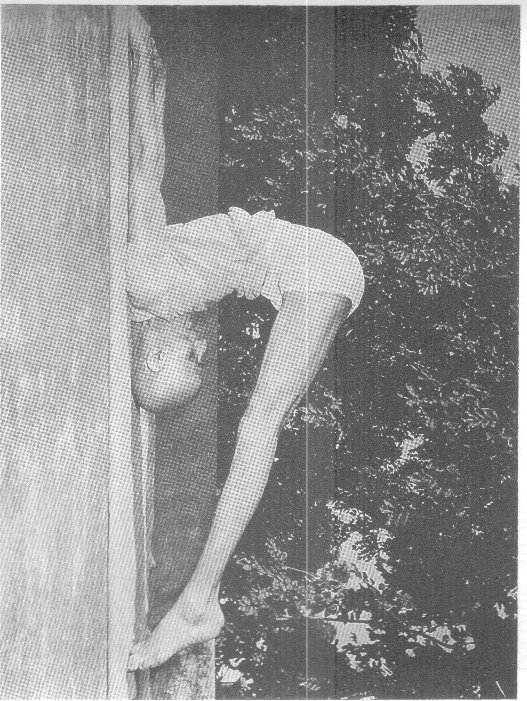
Benefits
In Bhujanga, Salabha and Dhanur Asanas the deep and superficial muscles are fully stretched and relaxed, but in Halasana the muscles of the back are fully stretched and relaxed. These muscles of the back are responsible for the healthy condition of the spine. The abdominal muscles contract vigorously and become strong. The whole spine is steadily pulled posteriorly. Every vertebra and ligament that is attached to it receive plenty of blood and become healthy. All the 31 pairs of spinal nerves and the sympathetic system are nourished well by copious supply of blood and toned nicely. This Asana prevents the early ossification of the vertebral bones. The vertebral column is twisted and rolled as it were like a piece of canvas. He who practises this Asana is very nimble, agile and full of energy. This Asana tones the spinal nerve, the sympathetic nervous system, the muscles of the back, and the vertebral bones. Various sorts of myalgia, lumbago, sprain in the neck, neuralgia are cured. Obesity or corpulence and habitual constipation, gulma, liver and spleen complaints are cured.
This can be styled as: "Standing Paschimot-tanasana." In Sanskrit "Pada" means 'feet', and "Hastha" means 'hands.'
Technique
Stand erect. Raise your hands over your head and inhale fully. Then exhale slowly and while exhaling slowly bend the body down till the hands reach the toes and the nose touches the knee. Keep the knees
PICTURE: PADAHASTHASANA
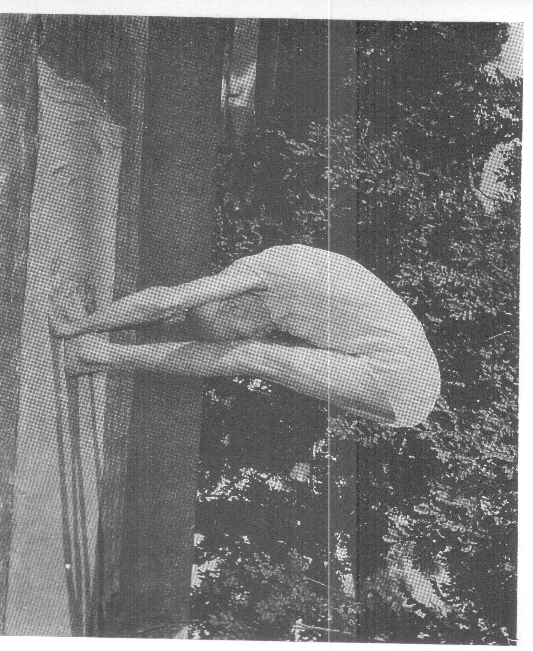
Stiff and erect. Do not bend the legs. The raised hands should be in touch with the ears all through even while bending the body. You can catch hold of the toes. In course of practice you can bury the face between the knees and keep the palms firmly on the ground. Remain in the pose for 5 seconds. Then slowly raise your body and come to the standing position. When you raise your body, then you can inhale slowly. Repeat this pose 4 times.
If you find it difficult to catch hold of the toes owing to the stiffness of the muscles of the hips and excess of fat in the abdomen, slightly bend the knees. After catching hold of the toes, straighten and stiffen the legs.
Benefits
All the benefits of Paschimottanasana are derived from this Asana. Spine becomes supple and is lengthened. It is an excellent exercise for increasing your height. The adipose tissue on the abdomen will disappear and the body is rendered light. This Asana is highly suitable to ladies to reduce excess of fat and to develop a graceful figure. You will feel much invigorated after performing this Asana. The body is rendered light, as much Tamas is dispelled.
Group 3—Backward Bending
In Sanskrit "Matsya" means a 'fish.' In this pose a person can float on water without swimming for a long time like a fish.
PICTURE: MATSYASANA
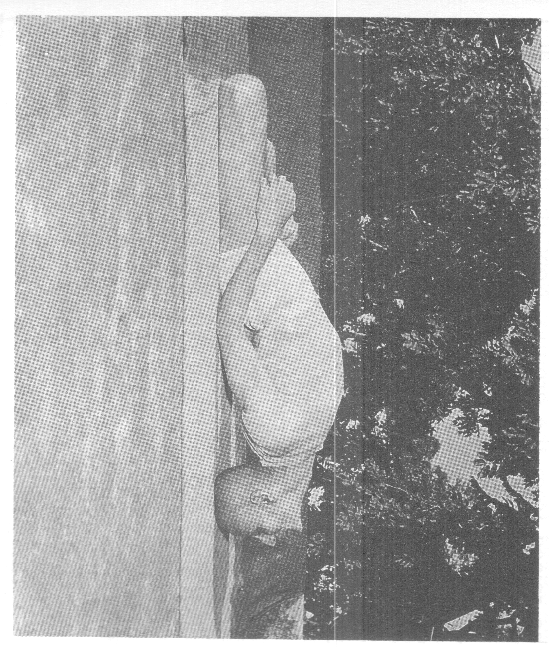
Technique
Spread a blanket on the ground and sit by stretching the legs. Bend the right leg and place the heel at the left hip joint. Again bend the left leg and place the heel at the right hip joint. This is Padmasana or foot-lock.
Then lie on the back. The Padmasana should not be raised from the ground. Now lift the trunk and head. Rest the top of the head on the ground by bending the back well. Then catch hold of the toes. This is Matsyasana. This must be performed immediately after Sarvangasana. Remain in the Asana for 2 or 3 minutes or half of the period that you devote for Sarvangasana. Then release the head with the help of your hands. Slowly assume the sitting posture and release the Padmasana.
Those fatty persons who find it difficult to form the foot-lock can simply bend the legs at the knees and practise this Asana. If you find it difficult to bend the neck and keep the top of your head on the ground, you can take your hands over the head. Keep the palms near the elbows and rest your head on the hands. In this pose you can float on the water.
Benefits
This Asana relieves the crampness of the cervical region and stiffness in the neck caused by long practice of Sarvangasana. Matsyasana gives natural massage, as it were, shampooing to the conjested parts of the neck and shoulders. In Sarvangasana the neck is well bent forwards while in Matsyasana the neck is bent backwards. It is a complimentary of Sarvangasana. In Matsyasana also the thyroid and Parathyroid receive plenty of blood. The waist, the back and the neck will grow strong. In this the practitioner can breathe freely and deeply, as the larynx or wind-box and trachea or wind-pipe are thrown open widely. The apices of the lungs which are located just behind and above the clavicular bone or collar bone in common parlance, receive proper fresh air and sufficient supply of oxygen. The cervicular and upper dorsal nerves are nourished with a good quantity of blood and toned properly. The endocrine glands, pituitary and pineal that are located in the brain are stimulated and toned also. These glands play a vital part in the physiological functioning of the various systems of the body. In this pose the abdominal muscles are pulled. So this Asana removes constipation and gives massage to the whole of the abdominal viscera or organs.
When this Asana is fully done, it gives the appearance of a hooded cobra. The raised trunk, neck and head represent the hood. Hence the significant name. "Bhujang" means a 'cobra' in Sanskrit.
Lie down on the blanket keeping the back above. Relax all the muscles completely. Place the palms below the corresponding shoulders on the blanket. Raise the head and upper portion of the body slowly just as the cobra raises its hood. Bend the spine well. Do not raise the body suddenly with a jerk. Raise it little by little so that you will find actually the bending of the vertebrae one by one and the pressure travels downwards from the cervical, dorsal, lumbar and lastly to sacral. Let the body from navel downwards to the toes touch the ground. Retain the posture for a minute and slowly bring down the head little by little. You can repeat the process six times.
PICTURE: BHUJANGASANA
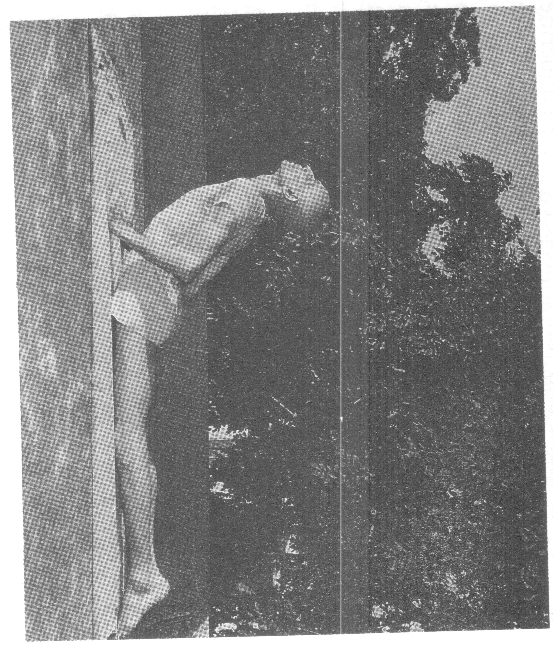
Benefits
All the Western physical culturists unanimously acclaim the importance of rendering the spine supple and elastic. Elasticity of the spine means health, vitality and youth of the individual. The deep and superficial muscles of the back are well toned up. This pose relieves the pain in the back due to over work. The abdominal muscles are pulled and thereby strengthened. The intra-abdominal pressure is in-creased to a very high degree and constipation is removed. All the organs in abdominal region are toned up. Every vertebra and its ligaments are pulled backwards and they get full blood supply. It increases the bodily heat and destroys a host of ailments. It gives good appetite.
Bhujangasana is particularly useful for ladies in toning their ovaries and uterus. It is a powerful tonic. It will relieve amenorrhoea, dysmenorrhoea leucorrhoea and various other utero-ovarine troubles.
When the Asana is performed, it gives the appearance of a bow. "Dhanu" means a tow.' The stretched hands and legs represent the string of a bow; and the body and the thighs represent the bow proper.
Technique
Lie prone on the blanket. Relax the muscles. Bend the knees and fold the legs over the thighs. Raise the head and chest. Catch hold of the right ankle with the right hand and the left ankle with the left hand firmly. Raise the head, body and the knees by tugging the hands and legs so that the whole burden of the body rests on the abdomen. The spine is nicely arched backwards like a bow. Keep the arm and forearm straight and stiff. Stretch the legs well and you can raise the chest. Keep the knees close.
PICTURE: DHANURASANA
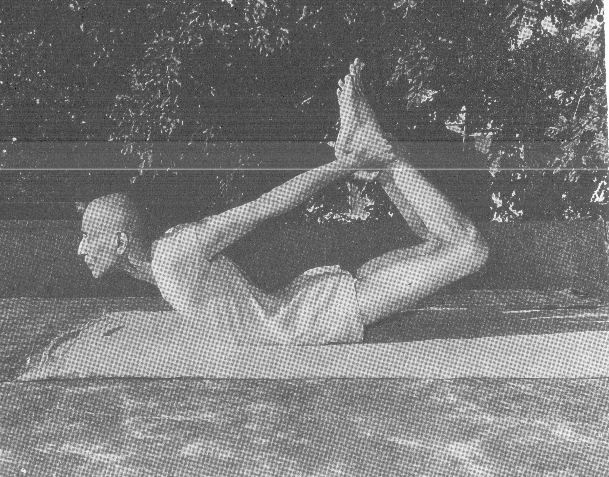
Maintain the pose for a few seconds and relax the body. You can either make a Kumbhak or breathe normally. Even weak persons can do this Asana beautifully. To perform the Asana a sudden movement of the body is required. Be steady. Do not have jerks.
Dhanurasana complements or supplements Bhujangasana. We can say it is a combination of Bhujanga and Salabha Asana with the addition of catching the ankles. Bhujanga, Salabha and Dhanura Asanas form a valuable combination. They always go together. They form one set of Asanas as it were. Dhanurasana can be repeated 3 or 4 times.
Benefits
The very appearance of the pose gives one the idea that it is a combination of Bhujangasana and Salabhasana. All the benefits of Salabha and Bhujanga Asanas can be had to a greater degree in Dhanu- rasana. The back muscles are massaged well. This removes constipation, dyspepsia, rheumatism and gastro-intestinal disorders. It reduces fat, energises digestion, invigorates appetite and relieves conjestion of blood in the abdominal viscera. This Asana is highly suitable to ladies. Hands and legs get thorough exercise.
In Sanskrit "Chakra" means a 'circle.' When this pose is demonstrated, it resembles a circle. Hence the significant name, Chakrasana. In fact it resembles more a bow than a circle. In Dhanurasana the weight of the whole body rests on the abdomen, while in Chakrasana the body is supported on hands and legs only. Many acrobats demonstrate this in the streets. Young boys can do this very easily as their spine is very elastic. When the bones become rigid and ossified in advanced age, bending the spine becomes difficult.
PICTURE: CHAKRASANA
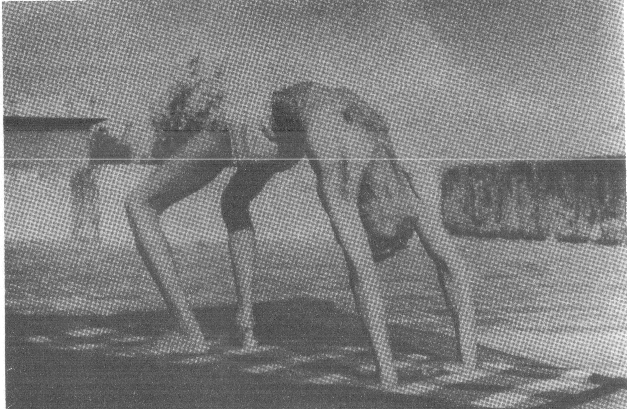
Technique
Spread a thick, blanket on the ground and stand on this. Raise the hands above. Slowly bend towards the back making a curve of the spine. When your hands reach your hip level, slightly bend the knees. This will help you to bend further. Now keep the palms facing the ground. Do not be in a hurry. Keep perfect balance of the body while bending further and avoid a terrible, sudden fall. When the palms reach the ground by slow adjustment bring the palms towards the feet as much as possible. Lean persons with elastic spine can catch hold of the ankle also easily. Remain in the Asana for 2 or 3 minutes and slowly raise the body little by little and assume the standing posture. This is Chakrasana.
If you find it difficult to do the Asana in the above manner, you can do this by the side of a wall. Stand 3 feet away from the wall. Raise your hands and turn the palms towards the wall. Keep the palms on the wall, fingers facing the ground. Slowly move the palms little by little towards the ground. The trunk will be forming a curve when the palms reach the ground. If this method is not suitable, you can ask your friend to catch hold of your hips firmly. Raise the hands and make a curve of the trunk. When the palms reach the ground, ask your friend to leave his hands.
Any of the above methods will not suit those persons who have a stiff spine and fat in abdomen. For them the following method will nicely suit. Lie down on the ground. Turn the hands and keep them on the ground near the shoulders. Now raise the knees and keep the heels near the buttocks. Raise the body slowly above. In this manner the trunk will form a nice curve. Bring the hands towards your heels by slow adjustment of balance. Remain in the Asana for 2 minutes. Keep the hands firm and release the legs one by one. Then release the hand one by one.
There is also another method by which the benefits of this Asana can be derived. Lie down flat. Keep the palms facing the ground near the shoulders? Now slowly raise the head, trunk, hips and thighs. Keep the elbows stiff and straight. This is shown in the illustration. Remain in the posture for 2 minutes and come down to the ground. You can repeat the exercise 2 or 3 times. This is also quite good.
Benefits
The practitioner will have perfect control of his body. He will be agile and nimble. He can turn out more work in a short space of time. All the parts of the body are benefited by this Asana. If you find it difficult to keep the Asana for a long time, lie down flat on the ground and again lift it up. When you stand on the Asana, the body will become light. You will get exhilaration of spirit at once. All the benefits that you derive from Dhanurasana, Bhujangasana can be derived from the practice of Chakrasana. Perform this after the practice of Padahasthasana or Paschimot-tanasana. You will derive maximum benefit. Arms, forearms, thighs and legs receive good strength from the practice of Chakrasana.
First you will have to learn to do Vajrasana or Adamantine Pose (as in the illustration on the next page). It resembles more or less the Namaz pose in which the Muslims sit for prayer. Spread a carpet and stand on your knees on the legs from toes to the knees on the ground. Now slowly sit down. The buttocks will rest on the soles and the thighs over the legs. Keep the trunk, neck and head straight. Place the palms over the knees. Keep the knees close. Do not bend at the elbows. This is Vajrasana.
You can sit in Vajrasana for a long time. Dyspeptics will derive much benefit. After food you can sit on this Asana for a short time. The muscles and the nerves of the legs and thighs are strengthened. Myalgia in the knees, legs, toes and thighs disappears. Flatulence is removed. The practice of Vajrasana exercises a stimulating, beneficial influence on Kanda, the most vital part, from which 72,000 Nadis spring. This is a very good exercise for the legs, thighs and spinal column.
Technique
Supta Vajrasana is a combination of Vajrasana and Matsyasana. In Supta Vajrasana more strain and force come on the knees than in Vajrasana. Sit in Vajrasana on a blanket. Keep the legs and the thighs firm. With the support of the hands and elbows, lie down quite flat on the back. Make a finger-lock and allow the head to rest on the palms. Instead of a finger-lock, you can keep the palms near the elbows as in Matsyasana. Remain in the Asana from 2 to 5 minutes.
PICTURE: VAJRASANA
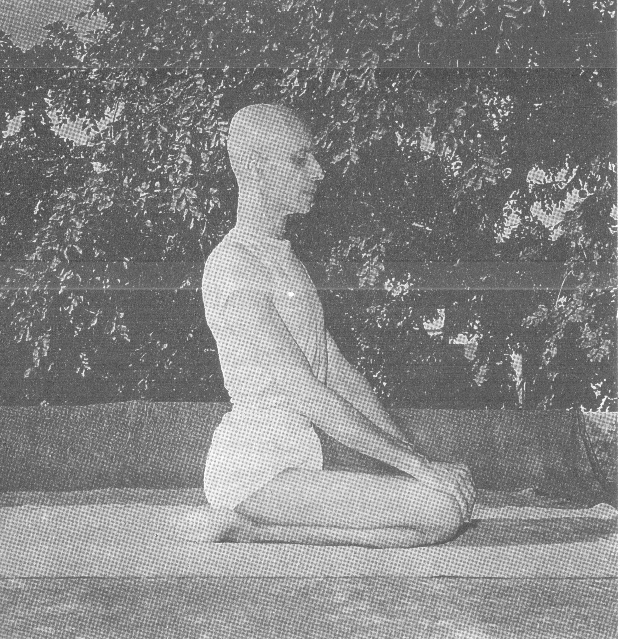
Benefits
In this Asana you will get all the advantages of Vajrasana. Hunchback is removed. Spine becomes elastic. This is a good exercise for the abdominal viscera and limbs. All the benefits of Matsyasana, Dhanurasana can be derived from the practice of this Asana. Do this after performing Paschimottanasana or Padahasthasana.
Group 4—Sideways Bending
"Trikona" means 'triangle.' Since this Asana gives the appearance of a triangle, when demonstrated, it bears the name Trikonasana.
Technique
Stand erect keeping the feet two or three feet apart. Now stretch your arms wide on the side in a line to the shoulders. The hands will be parallel to the ground. The palms should be facing the ground. Bend the spine at the hips to your left side slowly and touch the left toes with your left hand. You can slightly bend the head also. Remain for 5 seconds and slowly come to your standing position. Do not bend your legs or hand when you bend down and when you get up. From the standing position bend at the hips to your right and touch your right toes with the right hand as before. Remain for 5 seconds and then come to your original standing position. This is Trikonasana. Repeat this 4 times on each side.
Benefits
Trikonasana tones the spinal nerves and the abdominal organs, increases peristalsis of the bowels and invigorates appetite. Constipation is relieved. The body becomes light. Those who suffer from shortening of the legs due to fracture of hip or thigh bone or bones of the leg will be benefited by this Asana. The trunk muscles are contracted and relaxed and stretched. This movement keeps the spine very elastic. Mr. Muller also gives a description of this exercise in his system of Physical Exercises. For a Yogi the spine or Meru Danda is a great thing as it is connected with the spinal cord and the sympathetic system. Trikonasana practice keeps the spine in a healthy condition and thoroughly tones the spinal nerves.
PICTURE: TRIKONASANA
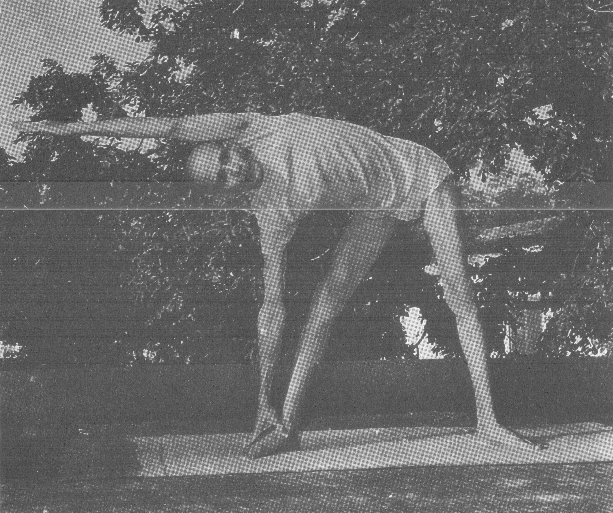
This is a familiar exercise among the students in the drill class. Stand erect keeping the hands at the sides (as in the illustration on the next page). Now raise one hand above the head very quickly with strain. Do not bend the hands. Then bring it to the former position. Again do the same with the other hand. Repeat this as many times as you can. The exercise can be done by taking the hands above simultaneously. Or when the hands reach the shoulder level, parallel to the ground, you can stop for a while and then take the hands above. The same exercise should be done by taking the hands up towards the front and sides also. This is a very good exercise for the hands. As soon as the exercise is over, massage the muscles of the hands and shoulders.
PICTURE: TADASANA
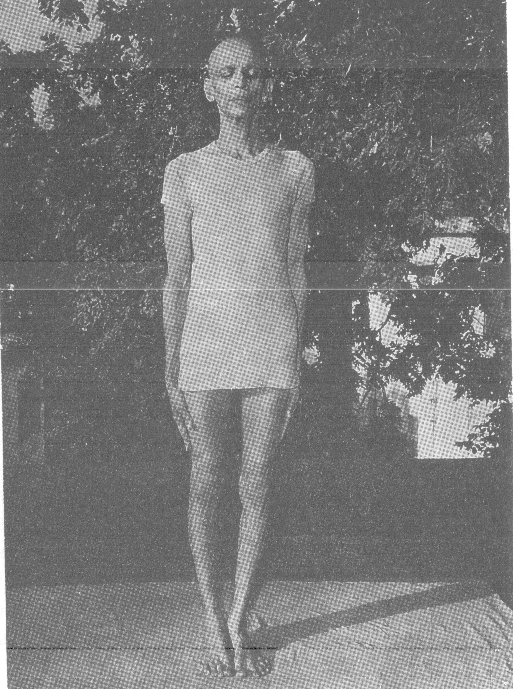
Group 5—Spinal Twist
"Ardha" means 'half.' This is half of Matsyendra-sana. This Asana takes its name from the Yogi Matsyendra, who first taught this Asana to the students of Hatha Yoga.
Technique
Spread a blanket on the ground and sit on it with legs stretched out. Bend the right leg at the knee and set the heel against the perineum. Do not allow the heel to move from this space. Bend the left leg at the knee and with the help of the hands arrange the foot to rest on the ground by the external side of the right thigh. Then passing the right hand over the left knee, catch hold of the left foot by the hands firmly. The left knee is placed at the right axilla. In order to have more mechanical advantage for twisting the spine, the left hand is now swung back and the right thigh is caught. Now steadily give a pull and twist the spine and turn towards the right. To help the spine twist evenly all through, the neck also is turned towards the left shoulder. Keep the chest erect and forward. Remain in the pose for 5 seconds. Then slowly release the hands and legs. Repeat the same process for twisting the spine on the right side by changing the limbs, thus accomplishing the twist on both sides. This will complete the spinal twist.
Benefits - Paschimottanasana and Halasana bend the spine forwards. Dhanur, Bhujanga and Salabha Asanas are counter poses to bend the spine backwards. This is not sufficient. It must be twisted and bent from side to side also (lateral movements). Then only the spinal column becomes elastic perfectly. Matsyendrasana serves this purpose well in giving lateral twist to the spinal column.
Ardha-matsyendrasana keeps the spine elastic and gives a good massage to the abdominal organs. Lumbago and all sorts of muscular rheumatism of the back muscles are cured. The spinal nerve-roots and sympathetic system are toned. They draw a good supply of blood. This is a very good Asana for constipation and dyspepsia. In this Asana every vertebra is rotated on both sides. The ligaments too that attach the vertebra get this movement and receive rich supply of blood. All the spinal nerves are toned. This Asana gives lateral movement to a great extent.
PICTURE: ARDHA-MATSYENDRASANA
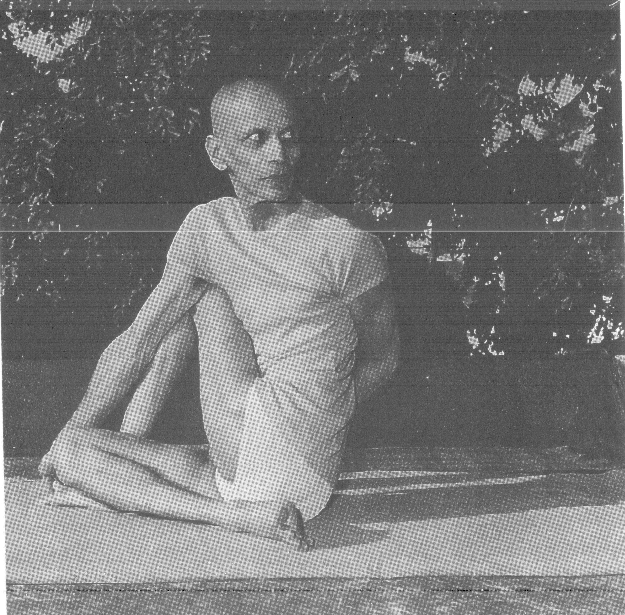
Group 6—Abdominal Exercises
"Salabha" means a locust in Sanskrit. When the pose is demonstrated, it gives the appearance of a locust with its tail raised.
Technique
Lie prone (on the face) on the blanket and keep the hands along with the body, palms facing above. Rest the chin on the ground by raising the head a little up. Now inhale. Stiffen the whole body and raise the legs above one cubit from the ground. The knees should be kept straight.
The sacrum too is raised a little along with the legs. Now the chest and the hands will feel the burden of the legs. Keep the thighs, legs and toes in a straight line. Remain in the pose for 20 seconds and slowly bring down the legs and then exhale slowly. Repeat the process 3 or 4 times according to your capacity. Do not go so far as to induce fatigue. Bhujangasana exercises the posterior part of the body and Salabhasana the lower extremity of the body. Some people keep the palms near the chest as in Bhujangasana.
PICTURE: SALABHASANA
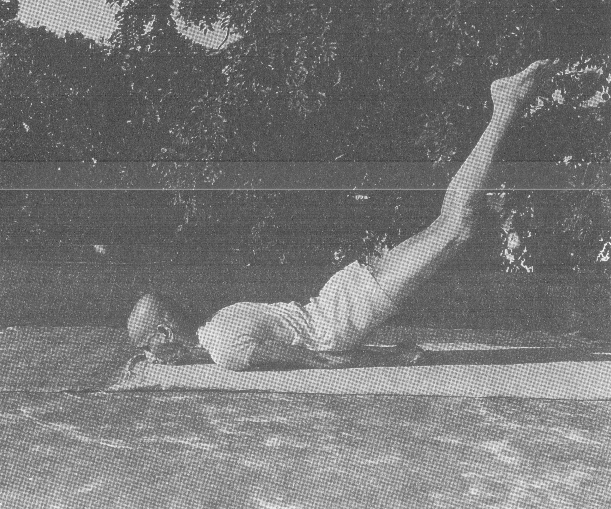
Benefits
The intra-abdominal pressure is increased to a very high degree. It relieves constipation and tones the liver, pancreas and kidneys. The whole of the abdominal muscles are strengthened to a very high degree. The vertebra of the lumbar and the sacrum bone get toned up. The sacral, coccygeal and the lower part of the lumbar receive plenty of blood supply and become healthy. Owing to the Kumbhak done during this pose, the lungs expand and become strong. It removes several diseases of the stomach and bowels. It cures sluggishness of liver. All forms of myalgia of the lumbar region are removed. This Asana gives a posterior curvature to the spine. It serves as an antidote, as it were, to Paschimottanasana or Padahasthasana. Bhujangasana develops the upper half of the body, while Salabhasana develops the lower half of the body and lower extremities.
In Sanskrit "Mayur" means 'peacock.' When this Asana is exhibited, it resembles a peacock which has spread out its bundle of feathers at its back. This Asana demands good physical strength.
Kneel on the ground over a blanket. Join the two arms together and rest them on the ground, palms facing the ground. Fingers should point to the feet. You can make a slight curve of the fingers. This facilitates balancing. Refer to the illustration. Keep the hands firm. Now you have got a steady and firm forearms for supporting the whole body. Bring down the abdomen slowly against the conjoined elbows. Support your body on your elbows. Then stretch your legs and rest the toes on the ground. Inhale and raise the legs together straight on a level with the head, parallel to the ground. Keep the posture steady for 5 seconds and then rest the toes on the ground and exhale. This is Mayurasana. Take rest for a few minutes. Gymnasts can do this Asana by holding the edges of a table.
PICTURE: MAYURASANA
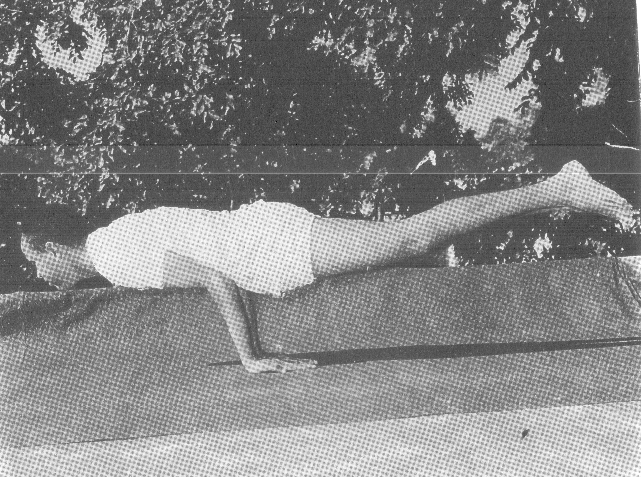
Benefits
This is an excellent Asana ever known for all stomach disorders. Owing to the pressure of hand on the stomach below the navel, the abdominal arota is partially compressed and the blood is directed towards the digestive organs. The liver, pancreas, stomach, kidneys are toned. The intra-abdominal pressure is increased to a very high degree and the whole of abdominal viscera is toned up. Mayurasana strengthens the muscles of the hands. Mayurasana awakens the Kundalini Shakti.
Mayurasana has got a charm of its own. It braces you up quickly. It serves like a hypodermic injection of adrenalin or digitalin. This is a wonderful Asana for digestion. It cures dyspepsia of stomach. Sluggishness of liver or hepatic torpidity disappears. This one Asana can give you maximum benefit of physical exercises in a minimum space of time, a few seconds daily.
This is a sort of swinging pose. This is a combination of Mayurasana and Padmasana. First you must practise Mayurasana for a long time. When you are able to do Mayurasana with ease and comfort, then you can take to Lolasana.
Stand in Mayurasana. Keep the pose steady. By bending the legs at the knees form Padmasana. This is Lolasana. You can form the Padmasana first. Keep the hands on the ground as in Mayurasana. The knees will rest on the ground. Rest the abdomen on the elbows and slowly raise the legs. This is also a good variety. All the benefits of Mayurasana can he had from this Lolasana.
Group 7—Science of Relaxation
Life has become very complex in these days. The struggle for existence is very acute and keen. There is very keen competition in every walk of life. The bread problem has become very difficult to be solved. There is unemployment everywhere. Even brilliant young men with extraordinary qualification and recommendations hardly get job in these days. Therefore, a great deal of continuous mental and physical strain is imposed on modern humanity by its deadening daily work and unhealthy mode of life.
Action produces movement; movement causes habits. Man has acquired many artificial habits. He has allowed nature's original habits to lapse. He has brought tension in many muscles and nerves through incorrect habit-positions. He has forgotten the first principles of relaxation. He will have to learn lessons from the cat, dog and the infant in the Science of Relaxation.
If you practise relaxation, no energy will be wasted. You will be very active, and energetic. During relaxation the muscles and nerves are at rest. The Prana or energy is stored up and conserved. The vast majority of persons who have no comprehensive understanding of this beautiful science of relaxation simply waste their energy by creating unnecessary movements of muscles and by putting the muscles and nerves under great strain.
Some persons shake their legs unnecessarily while sitting. Some play Mridang or Tabala (drum) with their fingers on the table when their minds are idle or vacant. Some whistle. Some shake their heads. Some tap their chests or abdomen with their fingers. Energy is thus dissipated or depleted through un-necessary movements of the parts of the body on account of lack of knowledge of the elementary principles of the science of relaxation.
Do not mistake laziness for relaxation. The lazy man is inactive. He has no inclination to work. He is full of lethargy and inertia. He is dull. Whereas a man who practises relaxation takes only rest. He has vigour, strength, vitality and endurance. He never allows even, a small amount of energy to trickle away. He accomplishes wonderful work gracefully in a minimum space of time.
When you wish to contract a muscle in order to perform an action an impulse is transmitted from the brain through the nerve to the muscle. Energy or Prana travels through the motor nerves, reaches the muscle and causes it to draw its ends together. When the muscle contracts it pulls the limb which you wish to move. Now you can perform the action with ease. First there is thought. Thought takes form in action through contraction of muscles.
Suppose you wish to lift up a chair. The desire creates an impulse in the brain. The impulse is transmitted to the muscles of the arms from the brain through the motor nerves. A current of prana or energy is transmitted along the nerves from the brain. The muscles contract and you perform the action of lifting up the chair. Similarly all other conscious or unconscious actions are performed by you. If the muscles are overworked more energy is spent and you get fatigue. There is much wear and tear in the muscles through overwork, strain and tension on account of heavy expenditure of Prana or energy.
When you perform an action consciously message is given to the mind and the mind immediately obeys by sending a current of energy to the desired part. An unconscious act is done instinctively or mechanically. The mind does not wait for orders. When the scorpion stings you in a finger, the finger is at once withdrawn. You do not argue here. This is an instinctive or mechanical movement.
A man of easily irritable nature cannot enjoy peace of mind. His brain, nerves and muscles are always under high tension. He is wasting every minute abundant muscular and nerve energy and brain-power. He is a very weak man though he is endowed with physical strength, because he loses his balance of mind very easily. If you really want to enjoy unruffled peace and abiding joy, you must try to possess a calm, controlled and balanced mind by eradicating worry, anxieties, fear, anger, and impulses.
You do not gain anything by worrying yourself unnecessarily and manifesting anger for nothing at all. Anger belongs to brutal nature. Anger does positive injury to brain, blood and nerves. You are not profitted a bit by exhibiting anger. By repeating an action, a habit is formed in the mind. If—you worry yourself frequently, a worrying habit is developed. Your vitality and energy are simply drained by worry, anger, fear. Why should you be afraid of anything at all, when everything is nothing but your own self? Fear, anger and worry are the products of ignorance. The muscles and nerves of a victim of anger and worry are always under contraction and high tension.
The action of one set of muscles can be checked by the operation of another set of muscles. One impulse may try to put one set of muscles in motion and by sending another repressive impulse through another set of muscles you can counteract the action of the first set of muscles. If a man abuses you, you may jump at once to beat him. An impulse has already put one set of muscles in motion. You may check the impulse through discrimination and reflection: "I do not gain anything by beating him. He is an ignorant man. He does not know how to behave. Let me forgive him now." A repressive impulse will check at once the operation of the first set of muscles by another set of muscles. Raising of impulses and counter-impulses or repressing or inhibitive impulses cause high tension in nerves, muscles and brain. Vast majority of persons are slaves of impulses; hence they do not enjoy peace of mind. They are tossed hither and thither
The science of relaxation is an exact science. It can be learnt very easily. Relaxation of muscles is as much important as contraction of muscles. I lay great emphasis on the relaxation of mind, nerves and muscles. For relaxation Savasana is Prescribed.
"Sava" means 'dead body.' When one performs this Asana, it gives the appearance of a dead body. So it is named Savasana. This is a closing pose. You will have to do this after doing all the exercises.
PICTURE: SAVASANA
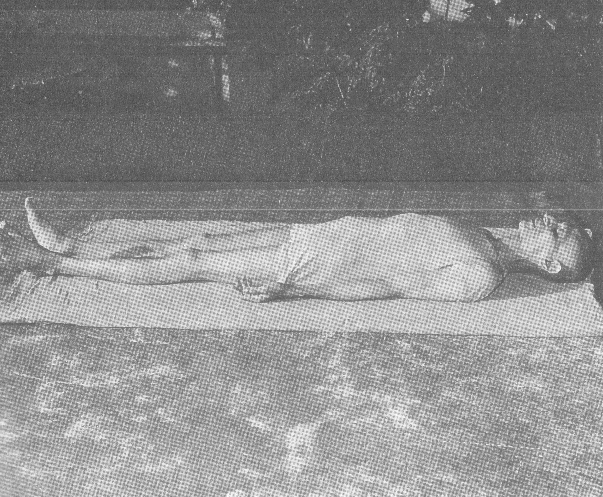
Technique
Spread a soft blanket and lie supine (on the back). Keep the hand on the ground by the sides. Let the legs be straight. Keep the heels together and the toes separated. Close your eyes. Now relax all the muscles of the body. Breathe slowly and rhythmically. Forget all your bubbling emotions and direct all your thoughts internally. Relax all muscles, nerves and organs. Start the relaxation process from the toes. Then proceed to the calf muscles, gastronemius, solens and plantaris muscles, muscles of the neck, face, etc. See that the abdominal organs, heart, chest, brain are also relaxed. Have an order. Do not sleep. In this pose you will enjoy perfect peace, ease, comfort and relaxation. You will have to experience beneficial results of this Asana. This must be done at the end of all the exercises. Then only the course will be complete.
Benefits
The pleasant and exhilarating feeling can only be realised by those who can successfully do this Asana. Words cannot adequately describe the feelings. Every one of you should enjoy it. If you are tired from a hard work, perform this Asana for 5 minutes. You will be fit again to continue your hard work with the same vigour. This is a blessing for all hard workers.
If you like, you can practise the relaxation by lying in an easy chair after finishing your Asanas or exercises. Those who know relaxation can take a small nap for ten minutes at any time they like. Busy people, doctors and lawyers should know the science of relaxation. They can relax the mind also and take rest in the waiting rooms of railway stations and bar rooms as well. They will be quite fit for further activity in the courts or the dispensary. Relaxation refreshes a man completely.
Students, journalists, busy lawyers, doctors and businessmen should know the science of mental relaxation. They should practise it also daily. Those who do not possess a knowledge of this science of internal and external relaxation waste their physical and mental energy considerably. Those who practise relaxation can conserve their physical and mental energy and utilise it to their best advantage. Yogis know this science well. They are perfect masters of this useful science. Those who practise relaxation will never experience fatigue. They close their eyes for a few minutes even while standing and get themselves ready for further work. Energy flows in their nerves when they relax just as water flows when the tap is opened.
Relaxation is a very important factor in muscular exercises. In Hala, Sarvanga, Paschimottan, Dhanur and Ardha-Matsyendra Asanas all the muscles of the body are stretched and contracted to an enormous degree. During intense muscular activity, the metabolism is increased. Metabolism is the anabolic and catabolic changes that take place in the body (wear and tear in the system). The muscles that are put under severe strain demand relaxation and rest. It is Savasana that promptly and efficiently ensures complete relaxation and perfect ease.
Group 8—Meditative Poses
Asanas can be divided into broad two divisions, viz., meditative poses and poses for health and strength. According to Yoga Sastras there are four excellent meditative poses: Padmasana, Siddhasana, Swastikasana and Sukhasana.
You must be able to sit on one of these four Asanas at a stretch for full three hours without shaking the body. Without securing a steady Asana, you cannot get on well in meditation. The more steady you are in your Asana, the more you will be able to concentrate and make your mind one-pointed.
Select any one of the four that is suitable to you and sit for fifteen minutes and gradually increase the period to three hours. When you sit on the Asana, keep the head, neck and trunk in one straight line. Do not bend the back.
When you sit for meditation on the Asana, close your eyes and gently concentrate on Trikuti (the space between the two eyebrows), tip of the nose, Anahata Chakra (the lotus of the heart).
This is one of the most important poses. When Padmasana is demonstrated, it gives the appearance of a lotus. In Sanskrit `Padma' or 'Kamala' means `lotus.' The two feet on the opposite thighs represent the petals of a lotus. It is known as Kamalasana.
Among the 4 poses, viz., Padma, Siddha, Swastika and Sukhasana prescribed for meditation, Padma-sana comes foremost. It is the best Asana for contemplation. Rishis like Gheranda, Sandilya and others speak very highly of this vital Asana. This is suitable for householders, men and women.
PICTURE: PADMASANA-1
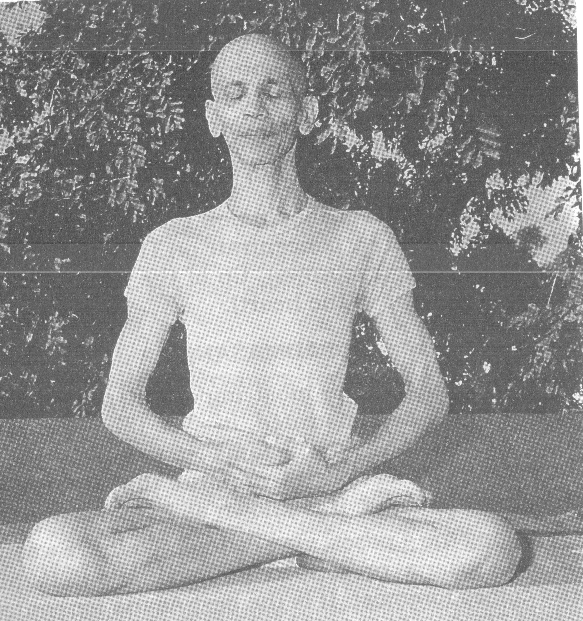
PICTURE: PADMASANA-2
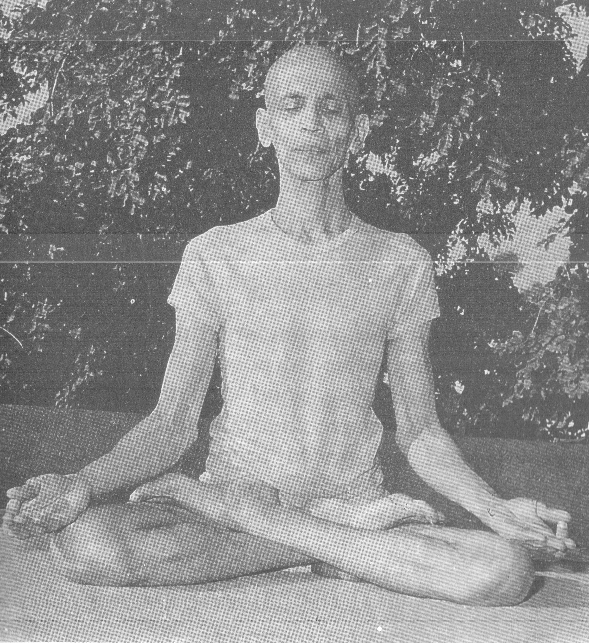
Technique
Any one of these Asanas is practised for Japa and meditation. In your meditation room, in front of the picture of your Ishta Devata or Guru, spread a Kusa seat (seat made of Kusa grass) and over this a deer or tiger skin. You can spread a piece of cotton cloth on this deer or tiger skin and then sit for meditation. Or spread on the ground a fourfolded blanket and a cloth over it. This also will serve you well.
Sit on this seat and stretch the legs forward. Take hold of the right foot with the two hands and folding the leg at the knee, place the foot on the left thigh. Similarly fold the left leg and place it on the right thigh. Keep the body erect and place the hands between the heels, one over the other as shown in the illustration. If this is not suitable to you, you can keep the hands on the knees. The left knee or thigh should not be raised from the ground.
Benefits
These meditative poses are highly suitable for Japa and contemplative purposes. They increase the digestive fire and give good appetite, health and happiness. They remove rheumatism. They keep the wind, bile and phlegm in proper proportion. They purify and strengthen the nerves of the legs and thighs. They are suitable for keeping up Brahmacharya.
This is practised for purposes of health. Sit in Padmasana. Keep the palms on the ground by your sides and raise the body, keeping the Padmasana (foot-lock) intact and steady. Remain for a few seconds and slowly come down to the ground. This is a very good exercise for the nerves and muscles of the hands.
"Siddha" means an 'adept' in Sanskrit. Since great adepts used to sit on this Asana for contemplative purposes, it bears the name Siddhasana. Siddhas (perfected Yogins) speak very highly of this Asana. Next to Padmasana comes Siddhasana in importance. Young Brahmacharins and those who attempt to get established in celibacy should practise this Asana. Many can do this better than Padmasana.
Technique
Sit on your seat. Stretch your legs forward. Bend the left leg at the knees and place the heel at the space between the anus and the scrotum. Then fold the right leg and place the heel against the pubic bone or just above the genitals. Keep the body erect and place the hands as in Padmasana (as in the illustration on page 78).
Siddhasana is called as Virasana, Muktasana and Guptasana. In Gheranda Samhita these Asanas are described with slight changes in the adjustment of legs.
"Swastika" means 'prosperous' in Sanskrit. This Asana brings prosperity, success and good health to the practitioner. Hence this pose bears the significant name, Swastikasana. Sitting at ease is also called as Swastikasana.
Technique
Sit on the seat. Stretch your legs. Bend the right leg at the knee and keep the heel against the groin of the left thigh so that the sole will be lying in close touch with the thigh muscles. Similarly bend the left leg and set it against the right groin. Insert the toes of the left leg between the right calf and thigh muscle. Now you will find the two feet between the calf and thigh muscles. Sit erect. This is very comfortable for meditation. Keep the hand as instructed in Padmasana.
PICTURE: SIDDHASANA
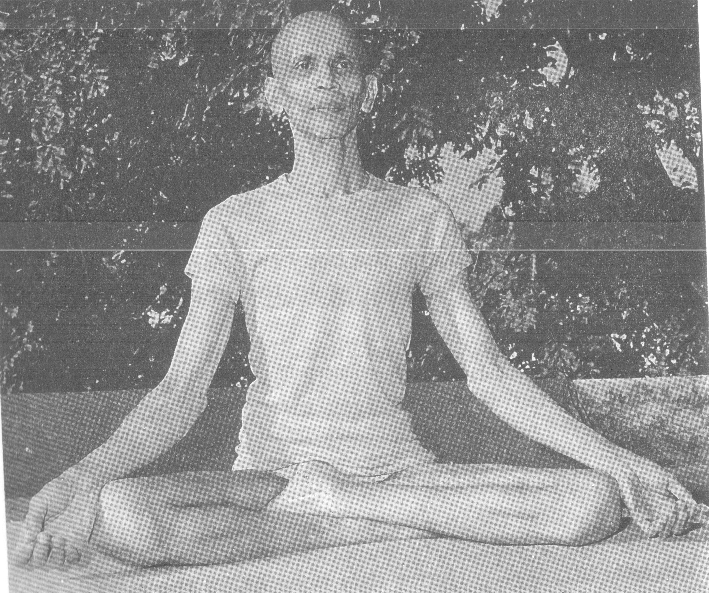
PICTURE: SWASTIKASANA
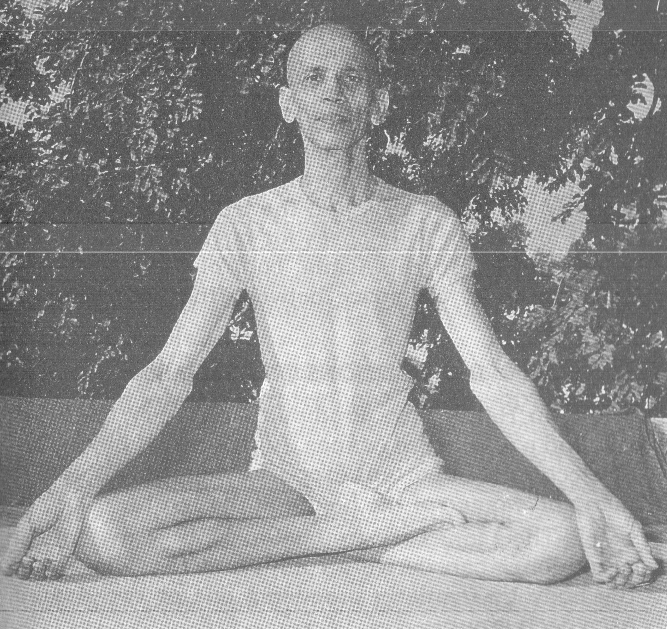
Swastikasana is also termed as Sukhasana. Any easy, comfortable posture for the practise of Pranayama, Japa and meditation, is Sukhasana. You can sit in any easy sitting posture, in which you can sit comfortably for a long time without shaking the body, keeping the head, neck and the trunk erect. You can select any of the four poses for meditative purposes. When you sit on the Asana, control the senses and concentrate at the space between the two eyebrows (Trikuti).
In Hatha Yoga Pradipika and other texts you will find a number of Asanas. In this book I have given a selection of important exercises that are suitable to men and women of the East and the West.
The Asanas are grouped in such a way that the practitioner can derive an all-round development of the body by regularly practising one or two Asanas from each group.
According to your temperament, capacity and time at your disposal you can select one or two Asanas from each group. You will have to practise at least one exercise from each group. This will give you an all-round development of the body.
In Group 2 all the Asanas bend the body forwards. In these Asanas some of the muscles are contracted. To derive the maximum benefit, you will have to immediately practise the Asanas that will stretch those muscles. For example, if you practise Paschimottanasana or Halasana or Padahasthasana, you will have to immediately practise Matsyasana, Bhujangasana, Dhanurasana, Chakrasana or Supta Vajrasana. For an all-round development of the body, you will have to do forward bending, backward bending, sideways bending, spinal twist, etc. Sava-sana should be done at the end of all the exercises. Then only the course will become complete.
For meditative purposes four Asanas are prescribed in Group 7. You can select that in which you can sit comfortably for a long time. These Asanas are suitable for practising Pranayama, Japa and meditation. When Bhaktas do Swadhyaya (study of scriptures), they can sit in the same Asana in which they sit for meditation.
To begin with, sit for 15 minutes and increase the period gradually to three hours. Then you will get Asana Siddhi or Asana Jaya, mastery over Asana. Then you can quickly advance in your meditation with one-pointed mind. Without securing a steady Asana, you cannot further get on well in meditation. The more steady you are in your Asana, the more you will be able to concentrate.
After some time if there is severe pain in the legs, unlock the legs and then shampoo them for five minutes and sit again on the Asana. When you advance by regular practice you will not experience any pain. You will experience on the other hand immense joy. Do not often change the Asanas, from Padmasana to Siddhasana and so on. Stick to one.
Books on Hatha Yoga eulogise the merits and advantages of Padma and Siddha Asanas to a very high degree. These Asanas increase the digestive fire and give good appetite, health and happiness. They remove rheumatism and keep the three humours, wind, bile and phlegm in proper proportion. They purify and strengthen the nerves of the legs and thighs. They are suitable for keeping up Brahmacharya.
Get up at 4 in the morning. Answer the calls of nature. Wash your face. Then practise your Asanas, Pranayama and meditation. If you devote long time for meditation, you can spend half an hour in Asanas and Pranayama and then sit for meditation. After meditation, take rest for half an hour or have a little stroll. Then you can take a full course of Asanas, Pranayamas, Mudras and Bandhas.
If you are not in the habit of answering the calls of nature in the early morning, you can practise the Asanas before going to the toilet. It is advisable that Yogic students should practise all exercises after attending to the calls of nature. Drink some cold water or luke warm water at night and in the early morning also as soon as you get up from bed. Regulate and adjust your diet also.
Wear a Langotee or Kowpeen or suspendary bandage when you practise the exercises. You can have a banian on your body. Do not wear spectacles when you do Asanas. They may be broken and injure your eyes.
Be regular in your practice. Those who practise by fits and starts do not derive much benefit. Regularity in the practice is very necessary if one wants to realise the maximum benefits of Asanas and Pranayamas. Generally people practise for two months in the beginning with great interest and enthusiasm and leave off the practice. This is a sad mistake. Practise the Asanas and Pranayamas regularly for a long time and realise the marvellous benefits.
Physical exercises draw the Prana out. Asanas send the Prana in. Asanas distribute Prana quite evenly throughout the body and different systems. Asanas are not only physical but also spiritual as they awaken the Kundalini Shakti. A particular Asana removes a particular disease. Asanas are preventative also. Asanas help a long way in controlling the senses, mind and body. Body nerves and muscles are purified.
In the beginning you will not be able to perform some of the poses perfectly. Regular practice will bring in perfection. Patience and perseverance, earnestness and sincerity are needed.
Mild Kumbhak (retention of breath) during the practice of Asanas augments the efficacy of Asanas and gives increased power and vitality to the practitioner. Japa and Pranayamas should go hand in hand with Asanas. Then it becomes real Yoga. Those who practise Japa, can repeat the Mantra during the practice of Asanas. Busy people who have a very little time at their disposal can have Japa during their practice of Asanas. It is something like getting four fruits by throwing one stone. You will get many Siddhis (psychic powers).
Those who practise Sirshasana and other exercises for a long time should take light tiffin or a cup of milk after finishing the whole course.
Commonsense should be used throughout your practice. If one kind of food is not agreeable to your system, change it after due consideration. If a particular Asana is not suitable to you, do not exert much. There must be joy and exhilaration in your practice. If a particular Asana is not suitable select some other from the same group. This is Yukti. If you cannot perform a particular Asana quite satisfactorily, do not lose heart. Where there is a will, there is a way. Try, try and try again. Continual practice and repeated attempts will give you success.
Abandon devitalising habits. Any habit which tends to lower the tone of the system will help to bring in various sorts of diseases. Anything which tends to lower the vitality, lowers the system's power of elimination. The use of alcoholic liquors, tobacco, cocaine, opium, Ganjah or cannabis indica, dissipations and excess of any kind must be given up entirely.
Asanas should be done both in the early morning and evening. They should not be done immediately after meals as the bodily energy is freely utilised in assisting digestion. They can be practised in a well ventilated room, open terrace, river bank, seashore or garden.
Sattvic food is necessary when you practise Yogic exercises. Take milk, ghee, sweet curd, fruits, biscuits, almonds, cream, etc. Give up garlic, onions, meat, fish, smoking, liquors, sour and pungent articles. Overloading the stomach must be avoided.
Immediately after performing the Yogic exercises, no physical exercise should be done, because all the Asanas are done to tone up the internal organs and tissues. Accordingly the blood has to be supplied to those systems and tissues. But the physical exercise is intended to tone up the muscles. So the blood will be drawn to the muscles. The circulation of blood in this case is completely opposite, and the benefits of Yogic Exercises will be nullified. After doing the exercises take rest for a few minutes and then begin physical exercises.
A Vedantin is afraid to do Asanas and Pranayamas on the ground that the practice will intensify Deha Adhyasa and militate against his practice of Vairagya. Though the two paths Hatha Yoga and Vedanta are different, yet a Vedantin can harmoniously combine Pranayamas and Asanas to his best advantage. I have seen many Vedantins in a sickly condition with very poor physique and dilapidated constitution. The body is closely related to the mind. A weak, sickly body means weak mind also. This body is a horse for you to take you to the goal. Though the body is Jada and useless, yet it is an important instrument for Self-realisation. It must be kept clean, strong and healthy. If a Vedantin does a little practice in Yogic exercises just enough to keep his body and mind healthy and strong, he can do very good Sadhana and reach the goal of life quickly.
Pranayama occupies a very important place in the Hindu Religion. Prana is related to mind, and through mind to will and through will to the individual soul, and through this to the Supreme Soul. If you know how to control the little waves of Prana working through the mind, then the secret of subjugating the universal Prana will be known to you. By controlling the act of breathing, you can efficiently control all different nerve-currents that are running through the body. You can easily and quickly control and develop body, mind and soul through the control of Prana. He who has conquered and controlled this very essence Prana, has not only subjugated his own body but every other body and mind in this universe. Pranayama is the means by which the Yogis try to attain perfection by getting all the power in the universe.
One who has a calm mind, who has subdued his Indriyas, one who has faith in the words of his Guru and Shastras, and one who is moderate in eating and drinking, and one who has an eager longing for deliverance from the wheel of birth and death—is a qualified person for the practice of Yoga. Such a man can easily get success in the Practice of Pranayama.
VRIKSHASANA or Tree pose: This is done in different ways. Sirshasana, is called as Vrikshasana. While performing Sirshasana, instead of forming a finger-lock, if you keep the two palms on the ground near the shoulders, it is Vrikshasana. You can find some gymnasts standing on two palms alone. It is another variety of Vrikshasana. Stand erect. Bend one leg at the knee and place the foot just above the other knee. Keep the hands near your chest, palms close to each other. Be steady in the posture. This is Vrikshasana. First stand on the left leg and then on the right leg.
PARVATASANA or Mountain Pose: Sit in Padmasana. Slowly raise the hands and body above. The knees alone will be resting on the ground. You can form a finger-lock also by keeping the palms outside or close together. If you cannot stand on the knees, you can sit on the ground and raise the hand. This is also quite good. Instead of sitting in Padmasana, you can sit in Vajrasana and then raise the body and hands. This body will be supported by the knees and toes only in this variety.
Paschimottanasana is also known as Ugrasana. Padmasana is called Kamalasana. Siddha-sana bears many names such as Virasana, Mukta-sana and Guptasana. Savasana is called Mritasana. In this way one and the same Asana is called by different names.
PRANAYAMA
Prana is the universal principle of energy or force. It is vital force. It is all-pervading. It may be either in a static or dynamic state. It is found in all forms from the highest to the lowest, from the ant to the elephant, from the unicellular amoeba to a man, from the elementary form of plant life to the developed form of animal life. It is Prana that shines in your eyes. It is through the power of Prana the ear hears, the eyes see, the skin feels, the tongue tastes, the nose smells, the brain and the intellect do their functions. The smile in young lady, the melody in the music, the power in the emphatic words of an orator, the charm in the speech of one's beloved are all due to Prana. Fire burns through Prana. Wind blows through Prana. Rivers flow through Prana. The aeroplane moves in the air through Prana. The steam engine works through Prana. Trains and motor cars move through Prana. Radio waves travel through Prana. Prana is electron. Prana is force. Prana is magnetism. Prana is electricity. It is Prana that pumps the blood from the heart into the arteries or blood-vessels. It is Prana that does digestion, excretion and secretion.
Prana is expended by thinking, willing, acting, moving, talking, writing, etc. A healthy, strong man has abundance of Prana or nerve-force or vitality. The Prana is supplied by food, water, air, solar energy, etc.
The supply of Prana is taken up by the nervous system. The Prana is absorbed by breathing. The excess of Prana is stored in the brain and nerve centres. When the seminal energy is sublimated, or transformed, it supplies abundance of Prana to the system. It is stored up in the brain in the form of Ojas.' Ojas is nothing but Prana.
The Yogi Stores abundance of Prana by regular practice of Pranayama just as the storage battery stores electricity. That Yogi who has stored up a large supply of Prana radiates strength and vitality all around. He is a big power-house. Those who come in close contact with him imbibe Prana, from him, and get strength, vigour, vitality and exhilaration of spirits. Just as water flows from one vessel to another, Prana actually flows like a steady current from a developed Yogi towards weak persons. This can be actually seen by the Yogi who has developed his inner Yogic vision.
Pranayama is the control of the Prana and the vital forces of the body. It is regulation of the breath. This is a most important step. The aim of Pranayama is the control of Prana. Pranayama begins with the regulation of the breath for having control over the life-currents or inner vital forces. In other words Pranayama is the perfect control of the life-currents through control of breath. Breath is the external manifestation of the gross Prana. A correct habit of breathing must be established by the regular practice of Pranayama. In ordinary worldly persons the breathing is irregular.
If you can control the Prana, you can completely control all the forces of the universe, mental and physical. The Yogi can also control the omnipresent manifesting power out of which all energies take their origin, whether concerning to magnetism, electricity, gravitation, cohesion, nerve-currents, vital forces or thought vibrations, in fact the total forces of the universe—physical and mental.
If one controls the breath or Prana, the mind is also controlled. He who has controlled his mind has also controlled his breath. If one is suspended, the other is also suspended. If the mind and the Prana are both controlled, one gets liberation from the round of births and deaths and attains Immortality. There is intimate connection between the mind, Prana and semen. If one controls the seminal energy, the mind and Prana are also controlled. He who has controlled his seminal force has also controlled his Prana and mind.
If you wish to hear a faint sound, the breath gets suspended for a short time. The coolie who carries heavy bags of rice at the railway station instinctively fills his lungs with air and practises unconscious retention of the air (Pranayama) till the bag is lifted on his back. He who crosses a small rivulet by jumping, he who practises long jump and high jump and various exercises in the parallel bars practises retention of the air instinctively. This retention of the breath augments his vitality, strength. It provides abundance of energy immediately.
Just as a goldsmith remove the impurities of gold by heating it in the hot furnace through blowing strongly the blowpipe, so also the Yogic student removes the impurities of the body and the Indriyas by blowing through his lungs, i.e., by practising Pranayama.
The chief aim of Pranayama is to unite the Prana with the Apana and take the united Prana-apana slowly upwards the head. The effect or fruit o Pranayama is awakening of the sleeping Kundalini.
The first important step is to master the Asana or the posture or to control the body. The next exercise is Pranayama. Correct posture is an indispensably requisite for the successful practice of Pranayama. Any easy comfortable posture is Asana. That pose is • the best which continues to be comfortable for the greatest length of time. The chest, neck and head must be in one vertical line. You should not bend the body either forwards or laterally, i.e., either on the right or left side. You should not sit crooked. You should not allow the body to collapse. You must not bend the body either forwards or backwards. By regular practice the mastery over the pose will come by itself. Fatty people will find it difficult to practise the Padmasana or the Lotus Pose. They can sit on the comfortable pose (Sukhasana) or Siddhasana (the perfected pose). You need not wait for practising Pranayama till you get full mastery over the Asana. Practise Asana and side by side you can practise Pranayama also. In course of time you will acquire perfection in both. Pranayama can be practised by sitting on the chair, also by sitting erect.
In Bhagavad Gita, the Immortal song of Lord Krishna, you will find a beautiful description of seat and pose:
"In a pure secret place, by himself, established in a fixed seat of his own, neither too high nor too low, with cloth, a black antelope skin and Kusa grass, one over the other. There making the mind one-pointed, with thought and the functions of the senses controlled, steady on his seat, he should practise Yoga for the purification of the Self. Holding the body, head and neck erect, firm, gazing steadily at the tip of the nose without looking around." [Chapter VI, 10-11 and 12]
Pranayama, though it concerns with the breath, gives good exercise for the various internal organs and the whole body. Pranayama removes all sorts of diseases, improves health, energises digestion, invigorates the nerves, removes passion and awaken Kundalini Shakti. It bestows good health and a steady mind. A Pranayama practitioner stops his breath. People break stones on his chest. He does not feel anything because he has controlled his Prana. A Pranayama practitioner will have a light body free from disease, very fair complexion, a sweet melodious voice, pleasant smell from his body.
He who practises Pranayama will have good appetite, cheerfulness, handsome figure, good strength, courage, enthusiasm, a high standard of health, vigour and vitality and good concentration of mind. Pranayama is quite suitable for people in the West and the East, men and women.
A Yogi measures the span of his life not by the number of years but by the number of breaths. You take in a certain amount of energy or Prana from the atmospheric air along with each breath. Vital capacity is the capacity shown by the largest quantity of air a man can inhale after the deepest possible exhalation. A man takes fifteen breaths in a minute. The total number of breaths comes to 21,600 per day.
The room in which you practise Pranayama must not be damp and ill-ventilated. It must be dry and airy. You can do the practice by the side of a river or lake, in the corner of a garden, in open air, when there is no chill or draught of cold air or on the top or foot of a hill. The practice of Pranayama should be performed daily with the mind firmly fixed on Truth. Then the Chitta is absorbed in the Sushumna. Consequently the Prana becomes steady. It does not fluctuate. Pranayama requires deep concentration and attention.
There should be no strain in any stage of Pranayama. You must experience joy and pleasure in doing the same. You should not feel any undue strain. Always inhale and exhale very slowly. Do not make the least sound. Whenever you feel uneasy, depressed, or dejected, practise Pranayama.
The practice of Kumbhak (retention) in Pranayama produces heat and thereby Kundalini Shakti is awakened and passes upwards along the Sushumna Nadi. Kumbhak increases the period of life also. Mild Kumbhak during the practice of Asana augments the efficacy of Asanas and gives increased power and vitality. During the practice of Pranayama repeat your Ishta Mantra (Japa). This will be purely Yoga.
As there is always some drowsiness when you get up from bed, it is advisable to do a few Pranayamas, 10 to 20 mild Kumbhaks just to drive off drowsiness and to make you fit for meditation. The mind gets one-pointed after the practice of Pranayama.
There are eight kinds of Pranayama exercises described in Hatha Yoga texts:
|
1. Suryabheda |
5. Bhastrika |
|
सूर्यभेद |
भस्त्रिका |
|
2. Ujjayi |
6. Bhramari |
|
उज्जयी |
भ्रामरी |
|
3. Sitkari |
7. Murcha |
|
शितकारी |
मूर्छा |
|
4. Seetli |
8. Plavini. |
|
सीतली |
प्लाव्हिनी |
In some books "Plavini" is taken as the eighth. In some other books Kevala Kumbhak is described as the eighth variety. Kapalabhati exercise belongs to the Shat Karmas. I have described it in the next Chapter. It is a variety of Pranayama exercises. For daily practice in the morning and evening, I am giving the "Sukha Purvak," Easy Comfortable Pranayama and then I will explain the technique of the above 8 varieties of exercises.
(Easy Comfortable Pranayama)
Sit on Padmasana. Close your eyes. Close the right nostril with the thumb. Draw in air very slowly through the left nostril. Now close your left nostril also with the ring and little fingers, and retain the breath as long as you can comfortably keep: Then very, very slowly exhale through the right nostril after removing the right thumb. Again draw in air through the right nostril, retain it as long as you can after closing both the nostrils, and exhale through the left nostril after removing the little and ring fingers. This is one Pranayama.
In Sanskrit inhalation is called as "Purak," exhalation as "Rechak" and retention as "Kumbhak." For closing the right nostril, right thumb is used. Keep the right palm open. Keep the fingers close. Now fold the index and middle finger. Thumb is used for closing the right nostril, and the ring and little lingers are used for closing the left nostril.
In the beginning, for a few days do only Purak and Rechak. After some practice, you can combine Kumbhak also. To start with, have Kumbhak only for 10 seconds and then gradually increase the period.
PICTURE: SUKHA PURVAK PRANAYAMA-1
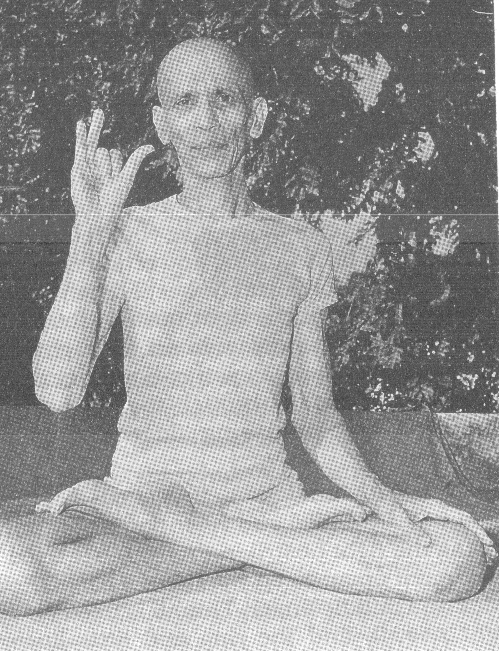
PICTURE: SUKHA PURVAK PRANAYAMA-2
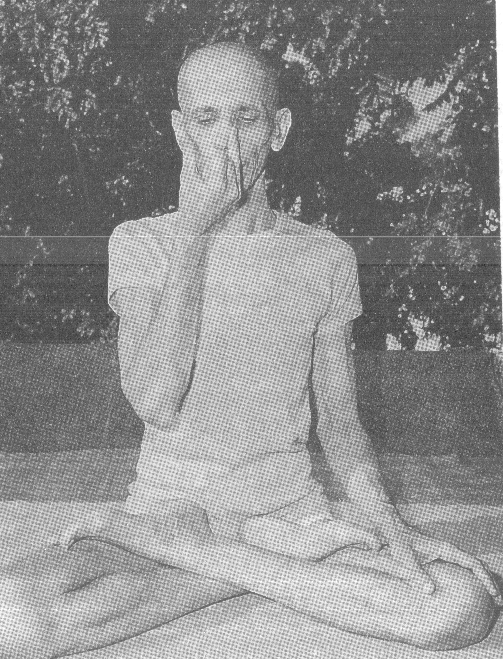
First you can do 5 Pranayamas in the morning and evening. After some practice you can do 10 Pranayamas. Gradually increase the number to 20, for morning and evening. Gradual, systematic practice is needed. Whole-time Yogic students can have four sittings.
The ratio for Purak, Kumbhak and Rechak is 1:4:2. If you inhale for 2 seconds, retain the breath for 8 seconds and exhale in 4 seconds.
During Purak, Kumbhak and Rechak repeat the Pranava (OM) mentally. Have a Bhava that all divine qualities (Deivi Sampat) such as mercy, love, forgiveness, peace, joy, etc., enter your system along with the inspired air and all devilish qualities (Asura Sampat) such as lust, anger, greed, etc., are thrown out along with the expired air.
Benefits
The body becomes strong and healthy. Too much fat is reduced by the practice of Pranayama. There is lustre in the face. Eyes sparkle like diamond. The practitioner becomes very handsome. Voice becomes sweet and melodious. The inner Anahata sounds are distinctly heard. The student is free from all sorts of diseases. He fully gets established in Brahmacharya. Appetite becomes keen. Nadis are purified. The mind becomes one-pointed. Rajas and Tamas are destroyed. The mind is prepared for intense Dharana and Dhyana.
Along with the practice of Pranayama, observe Mowna. Have Mithahara (moderation in diet). Take only Sattvic food. Devote more time for concentration, Japa and meditation. Keep up Brahmacharya. Live in a cool place. The inner spiritual force can be awakened quickly and you will feel ecstatic joy, spiritual light and peace of mind. An advanced Yogi acquires the eight major Siddhis (psychic powers).
In this Pranayama the inhalation and exhalation is done only through the Surya Nadi or right nostril, Pingala.
Sit on Padmasana or Siddhasana. Keep the left nostril closed with your right ring and little fingers. Slowly inhale through the right nostril without making any sound. Have a deep inhalation by taking in the air as much as you can. Form Jalandhara Bandha by pressing the chin against the chest. Retain the breath as long as you can after closing the right nostril with the thumb. Hold on your breath till perspiration oozes from the roots of the hairs. This point cannot be reached at the very outset. You will have to increase the period of Kumbhak by gradual practice. This is the limit of the sphere of the practice of Suryabheda Pranayama.
Then exhale through the right nostril after removing the thumb. You should not burst forth. Exhale very, very slowly. Inhalation should be in an unbroken, continuous force, without any stops or jerks in the middle.
Benefits
This Pranayama destroys the intestinal worms and diseases. This removes the four kinds of evils caused by Vayu and cures Vata (rheumatism). It cures rhinitis of the nose, cephalgia and various sorts of neuralgia. The worms that are found in the frontal sinuses are removed. It destroys decay and death and awakens the Kundalini Shakti. In this Pranayama, the three Bandhas can be practised nicely. For description refer to the exercise "Bandha Traya.”
Sit on Padma or Siddhasana. Close the mouth. Inhale slowly through both the nostrils in a smooth, uniform manner till the lungs become full. During inhalation a mild uniform sound is produced. Close both the nostrils and perform Jalandhra Bandha by pressing the chin against the chest. Retain the breath as long as you can comfortably do and then exhale very slowly through the left nostril. This Pranayama can be done even while you stand. In Gheranda Samhita it is described that after inhalation, the air must be drawn from the lungs and the mouth, filled up and then exhaled through the mouth.
This exercise removes the heat in the head. The practitioner becomes very beautiful. The gastric fire is increased. Asthma, consumption and all sorts of pulmonary diseases are cured. Perform Ujjayi to destroy decay and death. You can do this 4 times in the morning and evening.
Fold the tongue and touch the upper palate with the tip of the tongue. Slightly open the mouth and draw in air through the mouth slowly. If you find pain in the tongue, you can keep the tongue between the lips and draw in the air through the mouth. During inhalation you will hear a sound. Then exhale through the nostrils. This practice enhances the beauty of the practitioner and vigour of his body. It removes hunger, thirst, indolence and sleep. When you are thirsty, practise this. You will be relieved of thirst immediately.
PICTURE: SITKARI PRANAYAMA
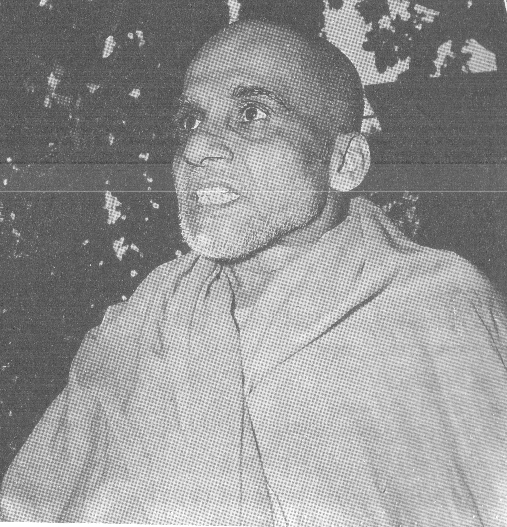
You can do this 10 times even. This can be done even during sitting or walking during day.
Fold the tongue like a tube, lengthwise. Protrude it a little away from the lips (as in the illustration on page 101). Draw in the air through the mouth with the hissing sound Si. Retain the breath as long as you can hold it with comfort. Then exhale slowly through both the nostrils. This can be practised for 10 or 15 minutes even, while sitting or standing or walking. This Pranayama purifies the blood. It quenches thirst and appeases hunger. It cools the system, and destroys Gulma (chronic dyspepsia), Pliha (inflammation of spleen), various chronic diseases, fever, consumption, indigestion, bilious disorders and other diseases. This removes poisons of all sorts from the blood. After a regular practice of this Pranayama for a long period, the blood becomes very pure that even the poison of snakes will not affect the body. When you feel thirsty practise Seetali. You will be immediately relieved of thirst.
Bhastrika' means bellows in Sanskrit. Just as a blacksmith blows his bellows rapidly with uniformity, so also you should move your breath. Rapid succession of forcible expiration is a characteristic feature of Bhastrika.
Sit on Padmasana or Siddhasana. Keep the body, neck and head erect. Make the palms rest on the knees. Close the mouth. Now inhale and exhale quickly twenty times like the bellows of the black-smith. Constantly dilate and contract the chest. Rapid expulsions of breath should follow one another in rapid succession. You can partially close the glottis. After twenty inhalations and exhalations, have a deep inhalation. Retain the breath as long you can do and then exhale very, very slowly through both the nostrils. Twenty expulsions make one round. You can do three or four rounds in the morning and evening. To begin with have only 10 expulsions for one round and gradually increase the number to 20. This Pranayama can be done while standing also by keeping the hands at the hips.
PICTURE: SEETALI PRANAYAMA
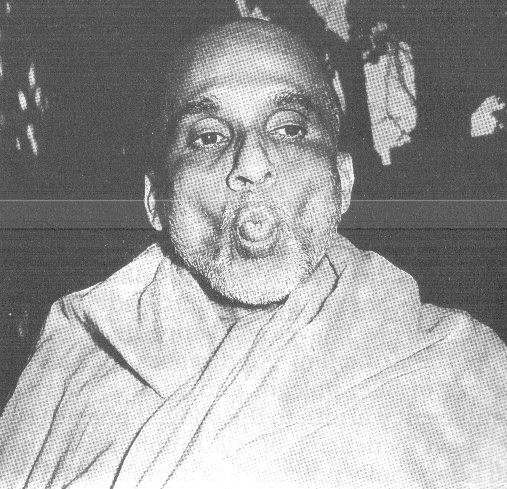
Some people prolong the practice till they get fatigued. You will get perspiration profusely. This is a very powerful exercise. If you experience slightest giddiness stop the practice and take a few normal breaths. After each round you can take rest for 2 minutes.
Bhastrika relieves inflammation of the throat, increases gastric fire, destroys phlegm, removes diseases of the nose and chest and eradicates asthma, consumption, etc. It gives good appetite. It enables one to awake the Kundalini. All diseases that arises from the excess of bile, phlegm and wind are removed. It gives sufficient warmth to the body. It purifies Nadis. It is the most beneficial of all Kumbhaks. Bhastrika should be specially practised as it enables the Prana to break through the three Granthis that are firmly located in the Sushumna. The practitioner will always be healthy.
The number of exhalations or rounds is determined by the strength and capacity of the practitioner. You must not go to the extreme. Repeat OM mentally with Bhay. There are some varieties of Bhastrika in which alternative nostrils are used for inhalation and exhalation.
Sit on Padma or Siddha Asana. Inhale rapidly through both the nostrils making the sound of Charawar, the male bee, and exhale rapidly through both nostrils, making the humming sound of a female bee. In Gheranda Samhita, Bhramari is described in another way. Close the ears with the two thumbs. Inhale through both the nostrils, retain the breath as long as you can do it with comfort and then exhale through both the nostrils. This should be practised in a secluded place in the night when there will be no sound from outside. You can hear Anahata sounds (inner mystic sounds). The joy which the practitioner gets in doing this Kumbhak is unlimited and indescribable. By success in this Kumbhak, the Yogi gets success in Samadhi.
Sit on your Asana and inhale deeply. Retain the breath by performing Jandhra Bandha (chin lock) by pressing the chin against the chest. Retain the breath till you expect fainting and then exhale very slowly. This is Murccha Kumbhaka as it makes the mind senseless and gives happiness. The period of Kumbhaka should be long, after a regular, gradual practice of Kumbhak. In Gheranda Samhita this exercise is described finely. "Sukena Kumbhakam"— you will have to retain the breath as long as you can do. You should not prolong the period beyond your capacity. When such kind of Kumbhak is practised, try to fix the mind on Atma. When the mind gets deeply concentrated for a long time, the mind will become senseless and you will experience joy and happiness.
By the practice of this Pranayama, one can float on water like a lotus leaf. After closing the glottis, little by little swallow the air and fill up the stomach till it gets bloated. If you tap the stomach when it is filled with air, you will get a peculiar tympanic (air) sound. By filling up the stomach and the lungs, one can float on water for hours together with complete ease and comfort. The air can be taken out from the stomach by gradual belching or by doing Uddiyana Bandha. The technique of this exercise will be quite clear if you see the process of swallowing the air, from an expert. He who practises this Plavini Kumbhak can live on air and dispense with food for a few days.
Kumbhak is of two kinds, viz., Sahita and Kevala. That which is coupled with inhalation and exhalation is termed Sahita. That which is devoid of these is called Kevala Kumbhak (retention alone.) Get perfection in Sahita and then take to Kevala.
After having inhalation through both the nostrils, practise Kumbhak (Gheranda Samhita Lesson V-92). You can practise this Kumbhak once in two or three hours also. Slowly try to increase the period of Kumbhak. In Kevala Kumbhak there are no regular Rechak and Purak. You will have to prolong the period of Purak. During Kumbhak you should withdraw the mind from all objects and firmly fix it on Atma or concentrate at the space between the two eyebrows, Ajna Chakra. By a practice of Kevala Kumbhak, the student attains the state of Raja Yoga.
By a practice of this Kevala Kumbhak, the knowledge of Kundalini arises. After a long practice, the student can hold on the breath as long as he likes. Kundalini is awakened and the Sushumna is free from all sorts of knots (Granthi). This Kumbhak promotes long life and destroys all sorts of diseases. He who knows Kevala Kumbhaka is a real Yogi.
MUDRAS AND BANDHAS
Press the anus with the left heel and stretch out the right leg. Slowly bend forwards and catch hold of your right toes with the hands. Inhale and retain the breath. Press the chin against the chest and form Jalandhra Bandha. Fix the gaze at the Trikuti. Retain the breath as long as you can comfortably hold on your breath. Then slowly raise the head and body and exhale. You can repeat this 4 to 6 times. In the same way do on the other side by pressing the anus on the right heel and catching hold of the left toes.
This cures consumption, haemorrhoids or piles, enlargement of spleen, indigestion, Gulma (chronic gastritis), constipation, fever, etc. Life is lengthened. It confers great Siddhis on the practitioners.
This posture is like Janusirasana. In Janusirasana you will have to expel and then bend. The head should reach the knees. This is something like Ardha (half) Paschimottanasana.
Sit on Padma Asana. Raise your body on your palms and strike the buttocks on the ground ten or twenty times hurriedly in quick succession. Keep the Mulabandha during the practice. Repeat this 2 or 3 times. Increase the number of beatings gradually. By doing this Kriya, Kundalini is awakened quickly.
Keep the left heel at the anus or in Kanda (two inches above the anus and two inches below the organ of generation) and place the right leg on the left thigh. Keep the finger-lock on the right knee and practise Bandha Traya (Mula Bandha, Uddiyana Bandha and Jalandhra Bandha). Concentrate on Sushumna at Muladhara. Do Pranayama 10 times. Then keep the right heel at the anus or in Kanda and the left leg on the right thigh and practise Pranayama 10 times with Bandha Traya. Generally the Yogi does Maha Mudra, Tadan Kriya, Maha Bandha and Maha Vedha. This is a good combination. Then only maximum benefits are derived. Maha Bandha destroys decay and death. The Yogi achieves all his desires and obtains Siddhis. The benefits of this Bandha are the same as Bandha Traya. But Maha Bandha awakens Kundalini quickly.
Maha Vedha is a combination of Tadan Kriya and Bandha Traya. Sit in Maha Bandha posture. Draw in the air through both the nostrils and retain the breath by doing Jalandhra Bandha. Now keep the palms on the ground. Raise the body and beat the buttocks gently from 10 to 20 times. While doing this, you must keep the legs intact. By keeping the legs at the anus as in Maha Bandha, if you cannot raise the whole body intact for Maha Vedha, you can sit in Padmasana. By this practice the air (Prana) enters into Sushumna. When you find that you are tired or Murccha supervenes inhale very, very slowly. Do this only once at each sitting and gradually you can increase the number? Do this in the presence of your Guru. This should be done after Tadan Kriya and Maha Bandha. This removes all the weaknesses of the body and awakens Kundalini.
Sit in Siddhasana. After a deep inhalation, close the ears with two thumbs, eyes with the index fingers, nostrils with the middle fingers, the upper lips with the ring fingers and the lower lips by the little fingers. This is a beautiful Mudra for doing Japa. You can do your Japa in the above posture. It is called as Baddha-Yoni Asana.
You will have to learn the technique of the Mudra directly from a Guru. You will have to meditate on the six Chakras and Kundalini along with the repetition of Bija Mantra and Pranayama. Far practising this Mudra successfully, you must perfectly be established in Brahmacharya. "Devanamapi durlabhd'—this is very difficult to be obtained even by Devas. By once obtaining perfection in this Mudra, the student attains the highest stage in Yoga.
Sit in Padmasana. Place the hands on the knees. Now exhale and bend forwards till your forhead reaches the ground. If you retain the pose for a long time, you can breathe in and out as usual. Or come to the sitting position and inhale. Instead of keeping the hands on the heels, you can take them towards the back. Catch hold of the left wrist with your right hand, and then bend forwards. This is a very good exercise for the abdominal organs.
PICTURE: YOGA MUDRA
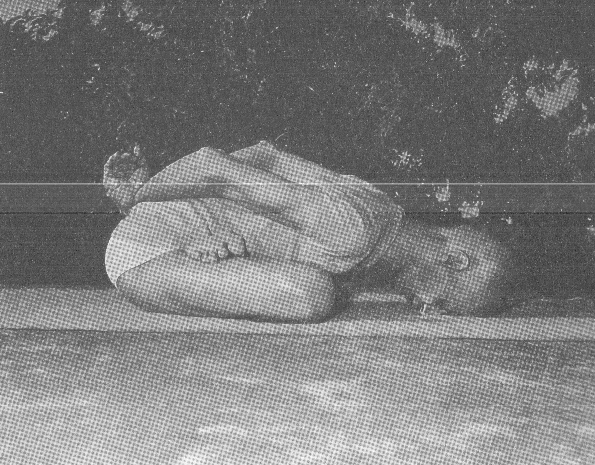
In Khechari Mudra the tongue and the mind remain in the Akasa. Kha means Akasa and Chan means to move. The Yogi moves in the Akasa.
The preliminary portion of this Mudra is in making the tongue long. The lower part of the tongue, frenulum lingua, should be cut a hair's breadth with a bright, clean knife. You can learn this under a Guru who is practising Khechari Mudra. The Guru will cut the portion little by little, weekly once. The lower part of the tongue can be anaesthatised with cocaine solution. After the cutting, the portion can be dusted with the powder of catechu, salt and alum, mixed in equal parts. This will prevent bleeding and help healing of the wound and salt will prevent the joining of the cut portion. The cutting should be continued every week till the tip of the tongue can easily reach the space between the eye brows. In some cases several cuts are necessary and it takes 2 or 3 years also. The student will have to take milk only on the day on which the tongue is cut. On other days rub the tongue with fresh butter and draw it out several times as much as possible. Thus the tongue can be lengthened. This is the preliminary portion of the Mudra.
Then sit on either Padma or Siddha Asana. Fix the gaze at the Trikuti, the space between the eyebrows. Turn the tongue and take it inside till the posterior nasal openings will be closed by the tip of the tongue. By practising this Mudra, the practitioner will be free from fainting, hunger, thirst, laziness. Life is prolonged. For days and months you can stop breathing. By doing Khechari Mudra Yogis bury, themselves under the earth and come out alive after 6 months even. In ancient days the Yogis used to fly in the air with the help of Khechari Mudra.
Sit in Padma or Siddha Asana. Contract the anus and draw the Apana Vayu upwards. The Apana Vayu which does the function of ejection of excreta has a natural tendency to move downwards. Through the practice of Mula Bandha, the Apana Vayu is made to move upwards by contracting the anus and forcibly drawing it upwards. This is Mula Bandha. It is highly useful for maintaining Brahmcharya... This is practised during inhalation in Pranayama and during Japa and meditation also.
Jalandhara Bandha is practised at the end of Purak, i.e., during Kumbhak or retention of breath. Contract the throat. Press the chin against the chest firmly. The gastric fire which is situated in the region of Nabhi consumes the nectar which exudes out of the Sahasrara Chakra through the hole in the palate. This Jalandhra Bandha prevents the nectar being thus consumed. The Prana is not allowed to escape outside through the practise of Jalandhra Bandha. When the period of Kumbhak is over, raise the head to its original position and keep the head, neck and trunk in a line and then exhale.
Uddiyana comes from the Sanskrit root `tit' and `di' which means when this Bandha is practised, the Prana flies up through the Sushumna Nadi. Hence the significant name.
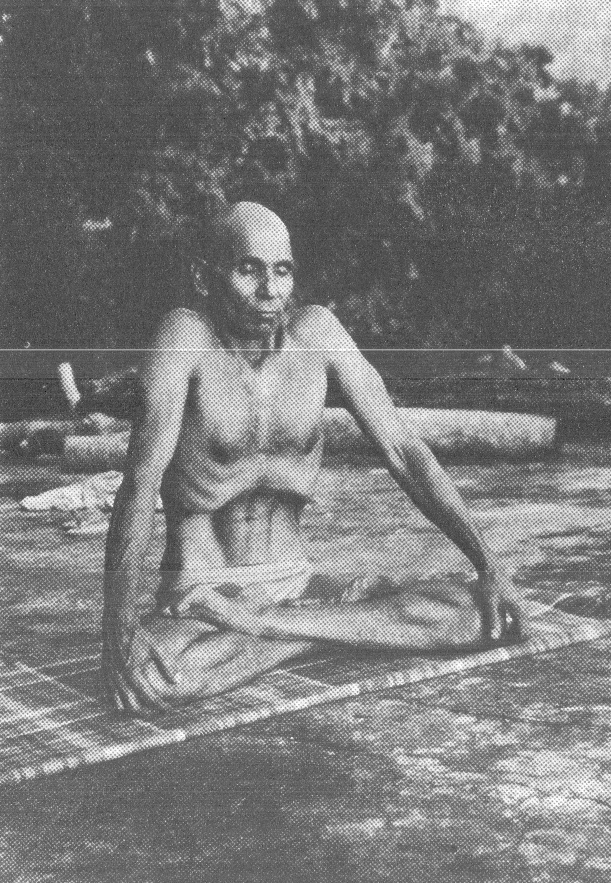
This is practised at the end of Kumbhak and the beginning of Rechak during the exhalation, the belly is slowly drawn backwards. The intestines above and below the navel are drawn up. The abdomen rests against the back of the body high up in the thoracic cavity. You can do this in a sitting posture during the practice of Pranayama or in a standing pose as an abdominal exercise. Repeat this Bandha 6 to 8 times. Uddiyana is the first stage of Nauli Kriya. Nauli is generally done in a standing posture, while Uddiyana can be done even in a sitting posture. The exercise helps a lot in keeping up Brahmacharya. It imparts beautiful health, strengh, vigour and vitality to the practioner. When it is combined with Nauli it serves as a powerful gastro-intestinal tonic. Nauli and Uddiyana are the two potent weapons of the Yogi to combat against constipation, weak peristalsis of the intestines and other disorders of the alimentary canal. By these two exercises you can manipulate and massage all the abdominal muscles. For abdominal exercises nothing can compete with Uddiyana and Nauli. They stand unique and unrivalled amongst all systems of physical exercise. In chronic diseases of stomach and intestines, where drugs of all sorts have failed, Uddiyana and Nauli have effected a rapid, thorough and marvellous cure. Nauli is described in the next chapter.
This is a combination of Mula Bandha, Jalandhra Bandha and Uddiyana Bandha. This is practised during Pranayama, while sitting in Siddhasana. The technique of all the Bandhas are given separately. Contract the anus during inhalation. This is Mula Bandha. During Kumbhak, form Jalandhra Bandha by pressing the chin against the chest. Then raise the head, exhale and draw the abdomen up in the thoracic cavity. This is Uddiyana, because Prana goes up the Sushumna in this Bandha. When the Apana is raised up and reaches the sphere of Agni (fire), then the flame of Agni grows long being kindled by Vayu. The Agni and Apana commingle with Prana in a heated state. Through this Agni, the sleeping Kundalini rouses now with a hissing noise, becomes erect like a serpent beaten with a stick and enters into the hole of Brahma Nadi (Susuhumna).
Practise 10 or 20 Pranayams with Bandha Traya daily in the morning and evening. Keep the ratio 1:4:2 as shown in Easy Comfortable Pranayama and gradually increase the number of Pranayamas in each sitting. Do not go beyond your capacity in retention of breath. There must not be any suffocation in the practice. You must so nicely adjust and regulate the Purak, Kumbhak and Rechak in such a manner that you will be able to do the whole of 10 or 24 Pranayamas with perfect ease and comfort. This exercise removes the fat in the belly. Kundalini is awakened quickly. All the benefits that are given in the Mula Bandha, Jalandhra Bandha and Uddiyana Bandha can be had from the practice of Bandha Traya.
Lie on the ground. Raise hip and the legs slowly up. Keep the legs straight. Keep the palms near your loins to support the legs. Remain steady. When this Mudra demonstrated it will be like Sarvangasana. The sun dwells at the root of the navel and moon at the root of the palate. The process by which the sun is brought upwards and the moon is carried downwards is called Vipareethakarani (topsy-turvy) Mudra.
The position of the sun and moon are reversed in this Mudra. On the first day do it for a minute and increase the period gradually. After six months wrinkles on the face will disappear. You can practise this even for two hours in the morning and in the evening. You can repeat your Ishta or Guru Mantra in this Mudra. As soon as the Mudra is over, you can take a cup of milk. Sirshasana posture also is called as Vipareethakarani Mudra.
Sit on Vajra Asana. Hold the right heel with the right hand and the left heel with the left hand. Keep the legs firm. Then raise the buttocks and beat them against the hands as many times as you can. At the end do the Bhastrika Pranayama with Kumbhak. Take a little rest and then repeat 2 or 3 times according to your strength and capacity. You can practise this Mudra for half an hour to one hour both morning and evening. The movement of the Prana in the Nadis can be felt or experienced by this practice. Nadis get purified quickly. This shakes the Kundalini. During the practice of all the Yogic exercises wear a Langotee or Kowpeen or a thin short drawers. Then only you can practise them with ease and comfort.
Contract and dilate the orifice of anus, the terminal opening of the alimentary canal several times. Sit on Vajrasana or Padmasana. It awakens Kundalini Shakti. Constipation is removed. You will get a tendency to answer the calls of nature after this practice. You can get a free motion. Mere contraction of the anus is Mula Bandha. In Aswini Mudra you will have to constantly dilate and contract. This is the difference.
Sit in Paschimottanasana. Make the stomach like a tank. For this you will have to exhale. Now do Paschimottanasana, and then Uddiyana Bandha. This is Tadagi Mudra. Then you can come to your sitting posture and inhale. You can repeat this 4 to 6 times. All the benefits of Paschimottanasana and Uddiyana Bandha can be drived from this Tadagi Mudra. This is a good abdominal exercise.
Sit in Padma or Siddha Asana. Keep your gaze at the tip of the nose (Nasikagra Drishti). Plunge in deep meditation. This is Bhuchari Mudra.
Plug the ears with balls of waxed cotton. Sit in Padma or Siddha Asana. Have deep concentration and meditation. In this you can hear the Anahata sounds. After a long practice, you can hear the Anahata sound without closing the ears.
Shambhavi Mudra occurs when the Lakshya (spiritual vision) is internal while the physical eyes are seeing externally, without winking. Fix the gaze between the two eyebrows. You will enter into natural Dhyana and Samadhi. You can develop the power of introspection. He who practises the Shambhavi Mudra is a real Yogi. This is an important Mudra.
Close the mouth. Take the tip of the tongue towards the palate. Taste slowly that nectar that flows from Sahasrara, the thousand-petalled lotus. This is Manduki (or frog) Mudra. This is the preliminary exercise of Khechari Mudra. By this Mudra the body retains perpetual youth.
Extend the neck a little forward. Close the glottis. Drink air through the gullet or aesophagus. This is something like a preliminary exercise of Plavini Pranayama. By performing Uddiyana Bandha, the swallowed air can be taken out. This is a good exercise for indigestion, dyspepsia.
Stand in neck-deep water or you can even use a wide basin of water or take water in both hands. Draw the water through the nostrils and throw it out by the mouth. This is "Vyut Krama." Then draw water through the mouth and throw it out through the nostrils. This is "Seet Krama." Repeat the process. Coryza, rhinitis and diseases of the nose are cured. Those who have a tendency to catch cold easily will become proof against cold. This is another form of Neti Kriya.
Raja Bhartruhari, Trilinga Swami of Benaras were experts in this Mudra. You will have to learn this Mudra from a Guru who is practising this Mudra. Now there are very few people who can do this Mudra. The students during the course of Sadhana draw water through a silver tube (catheter specially made) passed into the urethra. After some practice they draw milk, then oil, honey. They can draw mercury at the end even without the help of the silver tube. Even a drop of semen cannot come of the Yogi who practises this Mudra. The Yogi draws his semen up and preserve it as Ojas Shakti. Practice of Mula Bandha, Maha Bandha, Maha Mudra, Asanas and Pranayamas will help one to get success in Vajroli Mudra. This must be done under the direct guidance of a Guru.
KRIYAS
SHAT KARMAS
(Six Purificatory Exercises)
Hatha Yoga texts prescribe six exercises for the purification of the body. These exercises are not only for external and internal purification but also for strengthening the body. These exercises should be practised daily. The six purificatory exercises are: Dhauti, Basti, Neti, Nauli, Tratak and Kapalabhati.
Purification is of two kinds, internal and external. Internal purification can be made in several ways. Here you will find the technique of an important exercise.
VASTRA DHAUTI: Take a fine piece of cloth, 3 inches wide and 15 feet long. The borders should be stitched well and no loose thread should be hanging from the sides. Wash it with soap and keep it always clean. Dip it in tepid water. Squeeze out the water and swallow one end of it little by little. On the first day swallow only one foot and take it out slowly. After gradual practice you can swallow the whole length by catching one end of it firmly. Keep it in the stomach for a few minutes and then slowly take it out. Do not be hasty in pulling out the cloth forcibly. When the Kriya is over, drink a cup of milk. This is a sort of lubrication for the throat. Do this when the stomach is light or empty. Morning time is good. It will be quite sufficient if you practise this once in 4 or 5 days. This is an excellent exercise for those who are of a flabby and phlegmatic constitution. Gradual steady practice cures Culma, gastritis and dyspepsia and all other diseases of the stomach. This is Vastra Dhauti.
VATSARA DHAUTI: As stated in Plavini Pranayama, swallow air by closing the glotis. Keep it in the stomach for a few minutes. By practising Nauli and Uddiyana, you can force the air through the lower passage. Vatasara Dhauti is a similar exercise for internal puirfication by means of swallowing air.
BAHISHKRITA DHAUTI: This is the same as Vatsara Dhauti for purification of the internal organs through air. In Bahishkrita, retain the air for a long time in the stomach and then force it through the lower passage.
AGNISARA DHAUTI: Press the navel towards the spinal column. Draw the intestines and belly back. Release them slowly. Again draw in. Repeat this 108 times. This is Agnisara Dhauti or fire process cleansing. This Hatha Yogic Kriya increases the gastric fire (Jatharagni) and removes dyspepsia, gastraligia, gastrolinia, sour-belching and all other diseases of the stomach. This cleanses the impurities of the body. Chronic constipation is easily removed. Sluggishness of liver, enlargement of spleen are also cured. Excessive fat in the belly will disappear. The practitioner gets a shining and beautiful body. You will have a wonderful appetite. The body is cleansed by augmenting the inner gastric fire. Hence the significant name Agnisara. On the first day draw the belly and release it 12 times. Gradually increase the number to 108 times.
VAMANA DHAUTI: Fill up the stomach full with water. After a few minutes vomit it. The abdominal impurities are thrown out.
Other varieties of Dhauti are intended for cleaning the teeth, and tongue. External cleaning of the body is done through bath.
Basti is intended to remove congestion from the intestines. There are two varieties in this exercise, viz., Sthala Basti and Jala Basti.
STHALA BASTI: Sit on the ground. Stretch your legs. Now catch hold of your toes with the hands. This is like Paschimottanasana but here you need not bend much till your head touches the knees. Catching hold of the toes with the hands, churn the abdominal muscles slowly with a downward motion. Contract the sphincter muscles. After this practice, you will have a free motion.
JALA BASTI: This is more effective. Take a small bamboo tube of five inches long. Lubricate one end of it with vaseline. Sit in a tub of water or in a tank in knee level. Keep the feet on the ground. Balance the body on your toes only. This will be like Vajrasana, but the knees are raised and the body is supported on the toes. Now practise Aswini Mudra. Contract the anus. Draw the water into the intestines. Shake the abdominal muscles and expel the water. This is only for occasional practice to remove accumulation in intestines. Those who cannot draw water through the practice of Aswini Mudra, can use enema occasionally.
Unclean nostrils will lead you to irregular breathing. Irregular breathing will make you sick. Neti Kriya is intended for the purification of nostrils.
Take a fine piece of strong thread. There should be no knots in the middle. Insert one end of the thread into the nostril and catch hold of the other end firmly. By a deep inhalation, you can draw the thread inside and then slowly pull it out. Do this for both sides. The nostrils will be thoroughly cleansed. Refer to the technique of Matangini Mudra. This is also a form of Neti Kriya.
Nauli is a powerful exercise for regenerating, invigorating and stimulating the abdominal viscera and the gastro-intestinal or alimentary system. For the practice of Nauli, you should have a good practice of Uddiyana Bandha.
Stand by keeping your legs a foot apart and resting your hands on the thighs with a slight curve of the back. Do a strong and forcible expiration through the mouth and keep the lungs completely empty. Contract and forcibly draw the abdominal muscles towards the back. This is Uddiyana Bandha. This is the first stage of Nauli.
Then allow the centre of the abdomen free by contracting the left and right side of the abdomen. You will have all the muscles in the centre in a vertical line. This is called Madhyama Nauli. Keep it as long as you can retain the position comfortably. Then you can release the muscles and inhale. This is the second stage of Nauli Kriya.
After some practice, contract the right side of abdomen and allow the left side free. You will have all the muscles on the left side only. This is called Varna Nauli. Again contract the left side and allow the right side free. This is Dakshina Nauli. By having such gradual practice, you will understand how to contract the muscles of the central, left and right side of the abdominal muscles. You can also notice how they move from side to side. Have some practice like this for a few days.
PICTURE: MADHYAMA NAULI
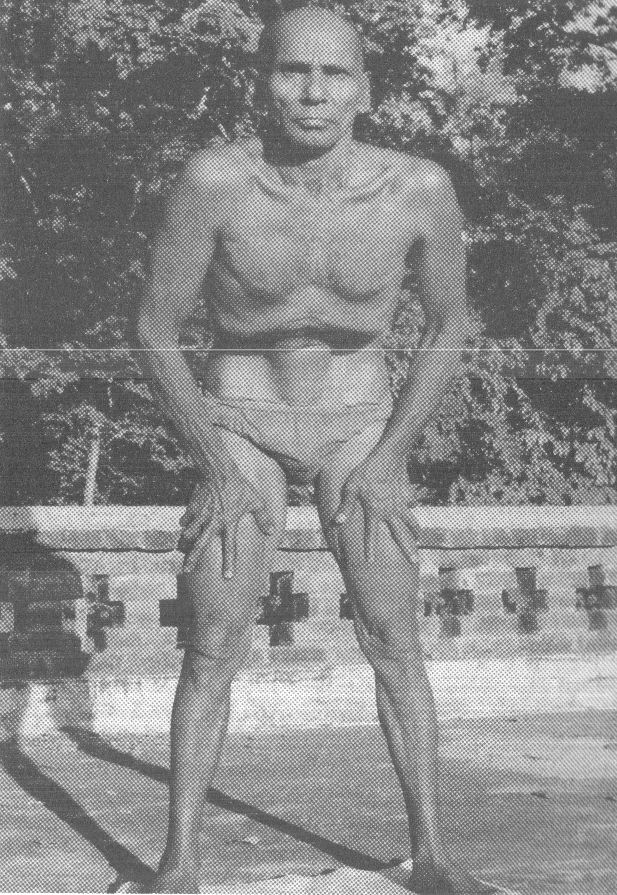
Then keep the muscles in the centre. Slowly bring them to the right side and then to the left side in a circular way. Do this several times from the right to left and then do it in a reverse way from the left to right side. You should turn the muscles always with a circular motion, slowly. When you advance in the practice you can do it quickly. This last stage of Nauli will appear like 'churning' when the abdominal muscles are isolated and rotated from side to side. When Nauli is demonstrated by advanced students, you will be extremely surprised to look at the movements of the abdominal muscles. You will feel as if an engine is working in the abdominal factory.
When beginners want to do Dakshina Nauli, they should slightly bend towards the left side and contract to left muscles. When they want to do Vama Nauli, let them bend a little to the right side. In Madhyama Nauli push the entire muscles forward by contracting the two sides.
Nauli Kriya eradicates chronic constipation, dyspepsia and all other diseases of the gastro-intestinal system. The liver and pancreas are toned. All other abdominal organs function properly. Nauli is a blessing to humanity. It is a sovereign specific or an ideal 'pick-me-up.'
This is steady gazing at a particular point or object without winking. This is mainly intended for developing the power of concentration and mental focussing. This is very useful for all students of Hatha Yoga, Bhakti Yoga, Raja Yoga and Jnana Yoga. Sit in Padma or Siddhasana. You can sit erect even on a chair. Keep the picture of your Ishta Devata or the picture of OM or a black dot on a piece of white paper. Look at the point or picture very steadily. You can gaze at a bright star or on the flames of a ghee lamp. Gazing at the tip of the nose and at the space between the eyebrows is also Tratak. When you gaze at a particular point or picture, it is Tratak. Close your eyes and form a mental picture of the object, it is Visualisation. Practise this for 2 minutes and cautiously increase the period.
Tratak improves eyesight. Diseases of the eyes are removed. Many have thrown away their spectacles after some practice in Tratak. It develops the power of concentration to a great degree.
Kapalabhati is an exercise for cleansing the skull. Kapala means 'skull' and Bhati means 'to shine.' This exercise makes the skull shining.
Sit on Padmasana or Siddhasana. Close the eyes. Perform Rechak and Purak rapidly. This should be practised vigorously. One will get perspiration profusely. This is a good exercise for the lungs also. Those who are well-versed in Kapalbhati can do Bhastrika very easily. Rechak should be done forcibly by contracting the abdominal muscles. Do 20 expulsions for a round and gradually increase the number to 120. In Kapalabhati there is no Kumbhak. Kapalabhati cleanses the respiratory system and the nasal passages. It removes the spasm in bronchial tubes. Consequently Asthma is relieved and also cured in course of time. The apices of the lungs get proper oxygenation. Consumption is cured. Impurities of the blood are thrown out. The circulatory and respiratory systems are toned to a considerable degree.
There is a variety in Kapalabhati in which you inhale through the right nostril and exhale through the right. Again inhale through the right and expel it through the left. Seet Karma and Vyut Karma described in Neti Kriya and Matangini Mudra are also a form of Kapalabhati Kriya.
RAMBLES IN YOGA
Kundalini is the primordial energy that lies in the basal Muladhara Chakra in a dormant potential state. Kundalini Yoga is that Yoga in which the Yogic student awakens the Kundalini and takes it to the Sahasrara Chakra in the crown of the head by piercing the lower six Chakras and attains highest knowledge and bliss through Nirvikalpa Samadhi. The Shakti is united with the Lord Siva at the crown of the head.
Kundalini dwells in the triangular hollow, celestial triangle (Trikona) in the Muladhara lotus resting upon the Svayambhu Linga. The three coils represent Her three Gunas and half-coil represents the Vikritis.
Sushumna extends from the middle of the Kanda to the head. Kanda means a bulb. Kanda is the root of all the Nadis. Two fingers above the anus and two fingers below the organ of generation is the Kanda. This is like the bird's egg in shape. It is of four fingers breadth in extent. Seventy-two thousand Nadis come out of this Kanda. Of all the Nadis Sushumna, Ida and Pingala are most important.
On the right and left of Meru or Merudanda (the backbone or the spinal column which extends from the Muladhara to the neck) are the Nadis Ida and Pingala. These two Nadis go upwards alternating from the left to the right and right to left. They go round the lotuses and make a plaited knot of three (Triveni) with Sushumna at the space between the eyebrows (Trikuti) and then run to the nostrils. That which comes from the right scrotum proceeds to the left nostril. That which comes from the left scrotum goes to the right nostril. Ida is the Chandra Nadi. It is cool. Pingala is Surya Nadi. It is hot.
Muladhara is a lotus of four petals. Kundalini lies coiled up here three and a half times. Muladhara is the name. Kundalini shines in the Muladhara Chakra like ten million suns shining at one and the same time. Earth is the element of this Chakra. Shakti Dakini resides here. Presiding Devata of this lotus is Brahma. This is the region of earth. Lam is the Bija.
Swadhishthana is another lotus placed inside the Sushumna at the root of the genitals. It is a lotus of six petals. Water is the element of this Chakra. Vam is the Bija. This is the Varuna-bija. Rakini dwells here. This is the region of water. Vishnu is the presiding deity.
Manipura Chakra is at the naval. It has 10 petals. This is the seat of the element of fire. Ram is the Bija. This is the region of fire. Lakini Shakti dwells here. The presiding Devata is Rudra.
Anahata Chakra is the lotus in the heart with 12 petals. This is region of Vayu. The Bija is Yam. Kakini Shakti dwells here. The presiding deity is Isha.
Vishuddha Chakra is the lotus in the throat with 16 petals. This is region of ether. Ham is the Bija. Shakini Shakti dwells here. The presiding deity is Sadasiva.
The Ajna Chakra is the lotus in the Trikuti, the space between the two eyebrows. It has two petals. This is the seat of the mind. Hakini Shakti dwells here. Presiding deity is Shambu. This is the region of Pranava.
Sahasrara Chakra is the thousand-petalled lotus that is located at the crown of the head. Parama Siva dwells here. The Kundalini unites with Siva in the Sahasrara. Now Nirvikalpa Samadhi results. In Samadhi the body is maintained by the nectar which flows from the union of Siva and Shakti in the Sahasrara. The pineal gland which is considered as the telepathic sense by occultists and which is regarded as the seat of the soul is situated in the Sahasrara. It is a vital body. When it operates it helps the Yogic student in the attainment of superconscious state or Nirvikalpa Samadhi.
The Yogi opens the mouth of Sushumna through Pranayama, Bandha and Mudras and awakens the sleeping Kundalini or the primordial energy in Muladhara and takes it to Sahasrara, at the crown of the head through the lower six Chakras. The lower six Chakras are the resting places of stages of Kundalini. He breaks the Brahma-granthi at Muladhara, Vishnu-granthi at Manipura and Rudra-granthi at Vishuddha. Granthis are knots or obstructions which prevent the ascent of Kundalini upwards.
Kundalini does not stay for a long time in the Sahasrara. The duration of stay depends upon the purity, degree of Sadhana, and inner spiritual strength of the Yogic practitioner. Many students stay in the lower Chakras only. They are carried away by the happiness they get in the lower Chakras and so they do not attempt further to reach the Sahasrara on account of the false satisfaction and content. Rasaswad of the happiness of the lower Chakras is an obstacle in their way of attaining the highest bliss of the Sahasrara. Just as a rich man in this world with all sorts of comforts and luxuries thinks that this world is everything and that there is nothing beyond, so also the Yogic practitioner who has ascended the lower Chakras falsely imagines that he has reached the highest goal and so stops his further Sadhana. After reaching the Sahasrara, the Yogic student should try his level best to prolong his stay there.
The Yogic practitioner should attempt to keep his awareness always. He will not gain anything if he gets Jada Samadhi. He will have no blissful spiritual experiences. He should try to avoid entering into this negative state.
Mind, Prana, Jiva and Kundalini move together in the upward ascent. The Yogic practitioner will get help from within when he moves from Chakra to Chakra. A mysterious power, a mysterious voice will guide him at every step. He should have perfect, unshakable faith in the Divine Mother. It is She who guides the Sadhak. It is She who takes Her child from Chakra to Chakra. She invisibly renders him all assistance. She pushes him up. Feel Her warm embrace. Feel Her grace at every step. Speak to Her like a child. Open your heart freely to Her. Be simple and candid. Say unto Her, "Mother Divine, I am Thine. Thou art my sole refuge and support. Protect me. Guide me. Have mercy on me." All your doubts will be cleared. She will do everything for you. Without Her grace you cannot move an inch in the spiritual path. You cannot move an inch in your ascent in the Sushumna.
If he (Yogic student) pierces the Muladhara he has conquered the earth. Earth cannot affect him. If he crossed the Swadhishtana he has conquered the element water, he is in touch with Bhuvarloka. If he has crossed the Manipura, he has conquered the fire. Fire cannot affect him. He is in touch with Swarga Loka. If he has crossed the Anahata Chakra, he has conquered the element air. Air cannot affect him. He is in touch with Maharloka. If he has crossed the Vishuddha Chakra, he has conquered the element Ether. Ether cannot affect him. He is in touch with Janaloka. If he has crossed the Ajna Chakra he is in touch with Tapoloka. Then he enters the Satyaloka. There are some other minor Chakras, Guru Chakra, Soma Chakra, Lalna Chakra, Manas Chakra, etc. between the Ajna and Sahasrara.
Kundalini holds the abundant flow of ambrosia by her union with Lord Siva in the Sahasrara lotus. When she comes down she bathes the Chakras with the nectar and gives them radiance. The Yogi experiences different kinds of bliss and powers at different centres. Fearlessness, unruffled state of mind, dispassion, constant meditative mood, desirelessness, content-ment, spiritual bliss, peace, inner spiritual strength, discrimination, self-restraint one-pointedness of the mind, strong faith in th existence of Ishwar, devotion, steadiness of mind, steadiness of Asana, purity, strong yearning for liberation, mercy, sweet voice, lustre in the eyes, peculiar glow in the face and charming personality are the signs that indicate that Kundalini is awakened and that it has entered the Sushumna after piercing the Muladhara Chakra. The more the ascent in the Sushumna, the more the spiritual experiences and the more these qualities and signs become marked and well-pronounced. Ultimately Kundalini unites with Her Lord Parama Siva at Sahasrara. Now Nirvikalpa Samadhi takes place. The Yogi attains liberation and gets highest knowledge and bliss. The Yogi is tempted in the lower Chakras or resting places. He should shun all Siddhis. Then only he will be able to proceed to his goal. Siddhis are obstacles in his path. If he begins to play with the Siddhis he will miss the goal and get downfall. Siddhis are temptations to distract the mind of the Yogic student who is not cautious and vigilant, who is not endowed with sustained Vairagya, or dispassion and discrimination.
The fruit that is allowed to ripen in the tree itself will be very sweet. But this takes a long time. First class timber comes out from the slowest growing trees. The tree that grows slowly for a number of years will become very strong and be useful for various purposes. Charcoal only becomes diamond after very many years. Even so that aspirant who does vigorous Sadhana for a long time with patience, perseverance and zeal, who sticks to the spiritual practices tenaciously despite various sorts of obstacles in the path, who admits his faults and weaknesses and tries to remove them by suitable methods will be able to awaken his Kundalini and will become a dynamic and perfect Yogi. Nowadays students are very impatient. They want to awaken Kundalini and become Yogis within a couple of months by doing a little Pranayama, Sirshasana and some Japa. If one becomes pure and free from all desires, Kundalini will awaken by itself and he will be benefited. If he awakens it by Hatha (violent) methods forcibly when his heart is impure, when desires lurk in his mind, he will come across temptations of various sorts when he moves from plane to plane and will have a downfall. He will have no strength of mind to resist these temptations.
May Mother Kundalini guide you all in your Yogic practices! May Her blessings be upon you all!
2. HOW TO AWAKEN THE KUNDALINI
Kundalini can be awakened when a man rises above desires of senses. The Yogi who has got pure heart and a mind free from passions and desires will be benefited by awakening Kundalini. If a man with a lot of impurities in the mind awakens the Shakti by sheer force through Asanas, Pranayamas and Yogic Kriyas, he will break his legs. He will not be able to ascend the Yogic ladder. People must have purity first; then a thorough knowledge of the Sadhana; a proper guide; and a steady gradual practice.
Kundalini can be awakened by Pranayama, Asana and Mudras by Hatha Yogins; by concentration and training of the mind by Raja Yogins; by devotion and perfect self-surrender by Bhaktas; by analytical will by the Jnanins; and by Mantras by Tantriks; and by the Grace of the Guru through touch, sight or mere Sankalpa. Rousing of Kundalini and its union with Siva at the Sahasrara Chakra effects the state of Samadhi.
Though Kundalini Shakti is of a serpentine form with 31/2 coils she may present Herself before Her dovotee in any form he likes. She can appear as Rama, Krishna, Hari, Siva, Durga or Gayatri.
The Yogic student actually visualises the serpentine power through his Divya Chakshu or eye of intuition.
There are four routes to Sahasrara for Kundalini Shakti to pass. The longest route runs from Muladhara to Sahasrara along the back. The Yogi who takes the Kundalini along this path is very powerful. This is the most difficult route. In Sri Sankaracharya the Kundalini passed along this route. The shortest route is from Ajna Chakra to Sahasrara. The third is from the heart to Sahasrara. The fourth route runs from Muladhara to Sahasrara in front.
If the Yogi concentrates on Ajna Chakra, the lower Chakras are automatically opened and conquered.
Just as there are six Chakras below Ajna, there are six Chakras above Ajna. They are Guru Chakra, Soma Chakra, Manas Chakra, Lalana Chakra, etc.
The aspirant sings and makes peculiar sounds when the Kundalini is awakened. He experiences various sorts of visions and Divya Gandha. He develops psychic powers. He sees a brilliant Jyoti as if ten thousand suns shine at the same time in the Muladhara.
That aspirant who is courageous, devotional, humble, generous, merciful, pure and dispassionate can easily awaken Kundalini.
When Kundalini is awakened there will be a peculiar vibration in the body and a powerful vibration in the Muladhara.
After Kundalini is awakened, Nature herself does all sorts of Kriyas, Asanas, Bandhas, Mudras and Pranayama, and forces the Kundalini upwards to Sahasrara.
PICTURE: SHAT CHAKRAS
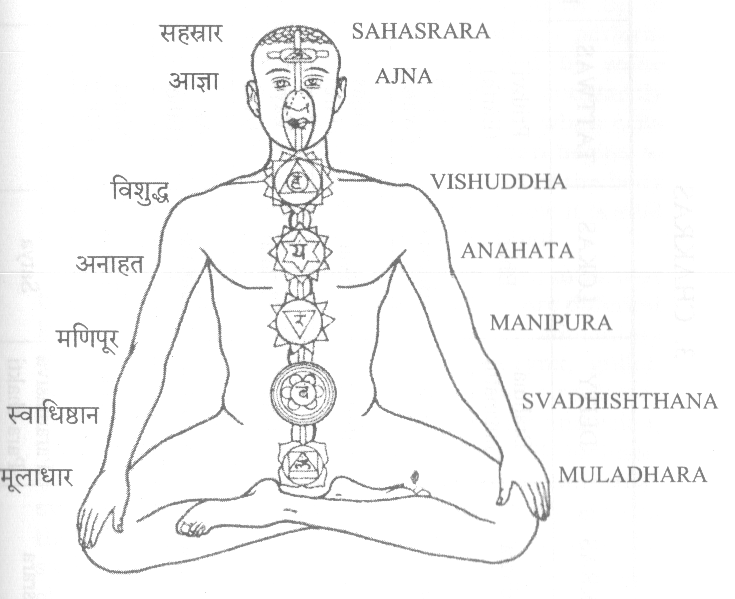
|
No. |
CHAKRAS
|
DEITY |
LOKAS |
TATTWAS |
No. OF PETALS |
BIJA AKSHARAS |
|
1 |
Muladhara
|
Brahma Ganapathi |
Bhur |
Prithvi (Earth) |
4 |
ल |
|
2 |
Svadhishtana
|
Vishnu |
Bhuvar |
Apah (Water) |
6 |
व् |
|
3 |
Manipura
|
Rudra |
Svar |
Tejas (Fire) |
10 |
र |
|
4 |
Anahata
|
Isha |
Mahar |
Vayu (Air) |
12 |
य |
|
5 |
Vishuddha
|
Sadasiva |
Janaha |
Akasa (Ether) |
16 |
ह |
|
6 |
Ajna
|
Sambhu |
Tapo |
Manas (Mind) |
2 |
ॐ |
|
7 |
Sahasrara
|
Paramasiva Para-shakti |
Satya |
|
1000 |
|
Many brilliant investigators in the mystery of life and death are still baffled as to this cause of decline and decay of the body. Life is kept up by the reproduction of the human cells. A cell is a mass of protoplasm containing nucleus. Man is made up of different groups and species of cells which perform different functions which are controlled by some co-ordinating mechanism. These cells are constantly broken down and renewed. A time comes when cells lose their power of reproduction. Now man begins to age. At one time it was said that every part of the body is wholly renewed every seven years but now it is said that the period is only about a year and half.
There are various kinds of tissues, viz., muscular tissue, fatty tissue, nervous tissue. There are different kinds of systems, viz., the digestive or alimentary system which consists of mouth, pharynx, gullet, stomach, small and large intestines; the circulatory system which consists of heart, the arteries and veins; the lymphate system which consists of lacteals, lymphatis and lymphatic glands; the muscular system; the integumentary system which consists of the skin or the epidermis, the cuticle or the dermis, the sweat glands which secrete sweat and the sebaceous glands which secrete sebum or fat; the urinary system which consists of kidneys, the bladder, the urethra; the reproductive system which consists of the reproductive organ in males and the uterus and ovaries in females and the endocrine system which consists of the thyroid and parathyroid in the neck, penials and pituitary glands in the brain and the adrenals, Metabolism is the sum total of the anobalic (constructive) and catobolic (destructive) changes that go in the tissue of the body.
One scientist believes that the secret of death is the blood system. He treats the blood with a chemical preparation. Another scientist believes that the seat of life is the thyroid gland. He therefore replaces a worn-out thyroid gland with a new young virile gland from a chimpanzee. Another scientist holds that the senility is due to dissipation affecting some major glands of the human body. Many weak, prematurely decrepit people are transformed into healthy men and women by the administration of extracts of these glands by injection or by mouth. These modern miracles happen every day. But they only restore diseased people to health, they do not prolong life beyond the normal span or solve the riddle of eternal youth. They will not even enable a healthy man of eighty to attain the age of hundred. That man will still die from the mysterious process of degeneration of cells which is called "old age."
Rejuvenation when the patient is elderly and the human machine the most magical of all machines is wearing out, has only a temporary effect as a bottle of whisky will stimulate a tired man. Relapse quickly follows. The eyes, bright for a short time become dull once more. The brain works vigorously for a brief period only. Afterwards weakness reasserts itself. The whole organism relapses into a state of greater decrepitude than before, because, it has been called to work beyond its strength and capacity by forced stimulation of the artifically treated glands. If scientists could discover the secret of persuading the cells which compose the human body to renew themselves even in old age as they do in youth, there would be no practical limits of human life.
Beauty, gracefulness, strength and adamantine hardness indicate that you are in possession of perfect body. As food is only a mass of energy, the body can be kept healthy and strong if you can supply the body the energy from any other source, such as sun, Cosmic Prana, Will, etc. Yogis know how to absorb the energy and utilise it for the economy of nature in the preservation of body. They possess the power to bear extreme cold and heat, the power to live without food and drink (drawing the energy from his pure, strong and irresistible will). Vayubhakshanam is another way of maintaining the body by eating or taking in the air. The body becomes indestructible. Nothing can injure it. There is no more disease, death or pain for that Yogi.
According to Yoga man's life is constituted of so many breaths. The number of respiration per minute is fifteen. If you can reduce the number of breaths by the practice of Kumbhak or retention of breath, or stop the breath through Khechari Mudra, you can increase your span of life.
Yogi Chang Dev who came on the back of a tiger to see Gyana Dev, the Yogi of Alandi in Maharashtra, lived for hundreds of years. Whenever Lord Yama, the God of Death, appeared before him he took his Prana into the Sushumna and entered into Samadhi. He thus defied the God of Death. Yogis attain the Siddhi to die at their will (Iccha Mrityu).
Preservation of the creative energy of man leads to perfection of body, rejuvenation and longevity. If the spermatic secretion in man is continuous, it must either be expelled or reabsorbed. As a result of the most patient and persevering scientific investigations, whenever the seminal secretions are conserved and thereby reabsorbed into the system, it goes towards enriching the blood and strengthening the brain. The conservation of this element is essential to strengthen the body, vigour of mind and keenness of intellect. All waste of spermatic secretions, whether voluntary or involuntary, is a direct waste of life-force. It is almost universally conceded that the choicest elements of the blood enter into the composition of the spermatic secretion. If these conclusions are correct, then it follows that a chaste life is essential to man's well-being.
Brahmacharya is the basis for the attainment of perfection of body or Kaya Siddhi. Complete celibacy must be observed. This is of paramount importance. By the practice of Yoga the semen becomes transmuted into Ojas Shakti. All the cells are vivified or galvanised by the power of Ojas. The practice of Brahmacharya, Pranayama, Sirshsana, and other Hatha Yogic Kriyas and meditation entirely renovates the system and gives new strength, vigour and vitality to the cells. There will be a charm and grace in the movements of the practitioner. He can live as long as he likes. That is the reason why Lord Krishna says to Arjuna "Tasmat yogi bhava—Therefore become a Yogi."
If a Yogi acquires Kaya Siddhi or perfection of this body, all diseases and tendencies to diseases will vanish. He will not be affected by the pairs of opposites, viz., heat and cold. There will be diminution or disappearance of excretions. The craving of hunger and thirst vanishes. He may take very little food or completely abandon food. Pain of all sorts disappears. He may experience some pleasant feelings in place of heat and cold and pain. The Siddhis of Anima, Mahima, Laghima come under Kaya Siddhi.
The process of rejuvenation through the admini-stration of Kaya Kalpa according to the method of Yogis and Rishis, is not to be confounded with that of the Western method of scientists and doctors, where the object is purely on the physical basis. The process of rejuvenation through "Kaya Kalpa" is in the keeping of great Tapasvins. Kaya Kalpa is the real elixir of life by which the Rasayanas make the body immortal. They can keep the body strong and healthy as long as they like. The body is an instrument to attain the goal of life. Suppose a man desires to practise Yoga. He dies before he attains the highest Nirvikalpa Samadhi. Then he takes up another body and starts again the Yogic practices. He dies again before he makes any substantial progress. In this manner much time is lost in dying and being born again. Therefore if the body is rendered strong and healthy, if birth and death can be got rid off, you will have ample time to do Yoga Sadhana to attain the goal of life in one birth. This is the theory of Rasayanas. They teach to immortalise the body first by means of Kaya Kalpa made out of herbs or mercury or sulphur, Neem or Amalaka fruits in order to achieve the goal of Yoga in this very life.
The body is the mould prepared by the mind for its operation. It is the mind that manufactures the body. This physical sheath is thrown out at death and the mind puts on a new cloth by throwing out the worn-out garment. The mind can draw any amount of power from the universal storehouse of energy. If the mind can manufacture another new body in the next birth, why can it not do just here and now without dissolving this present body by renewing the cells which make up this human body? This is the theory of Rasayanas. This theory is quite correct, sound, logical and tenable.
"Desa bandaschittasya dharana Concentration is fixing the mind on any point, external or internal." There can be no concentration without something upon which the mind may rest. A definite purpose, interest, attention will bring success in concentration.
The senses draw you out and perturb your peace of mind. If your mind is restless, you cannot make any progress. When the rays of the mind are collected by practice, the mind becomes concentrated and you get Ananda from within. Silence the bubbling thoughts and calm the emotions.
You should have patience, adamantine will and untiring persistence. You must be very regular in your practices. Otherwise laziness and adverse forces will take you away from the Lakshya. A well-trained mind can be fixed at will upon any object either inside or outside to the exclusion of all other thoughts.
Everybody possesses some ability to concentrate in some lines. By the spiritual progress, concentration should be developed to a very high degree. A man with appreciable degree of concentration has more earning capacity and turns more work in a shorter time. In concentration there should be no strain in the brain. You should not fight or wrestle with the mind.
A man whose mind is filled with passion and all sorts of fantastic desires can hardly concentrate on any object even for a second. Celibacy, Pranayama, reduction of wants and activities, renunciation of sensual objects, solitude, silence, discipline of the senses, annihilation of lust, greed, anger, non-mixing with undesirable persons, giving up of newspaper reading and visiting cinemas—all will increase the power of concentration.
Concentration is the only way to get rid of worldly miseries and tribulations. The practitioner will have a very good health and cheerful mental vision. He can get the penetrative insight. He can evolve quickly. He can do any work with greater efficiency. Concentration purifies and calms the surging emotions, strengthens the current of thought and clarifies the ideas. Purify the mind first through Yama and Niyama. Concentration without purity is of no use.
Japa of any Mantra and Pranayama will steady the mind, remove Vikshep and increase the power of concentration. Concentration can be done only if you are free from all distractions. Concentrate on anything that appeals to you as good or anything which the mind likes best. The mind should be trained to concentrate on gross objects in the beginning, and later on you can successfully concentrate on subtle objects and abstract ideas. Regularity in the practice is of paramount importance.
Gross forms: Concentrate on a black dot on the wall; a candle flame; a bright star; moon; on the picture of OM, Lord Siva, Rama, Krishna, Devi or your Ishta Devata in front of you with open eyes.
Subtle forms: Sit before the picture of your Ishta Devata and close your eyes. Keep a mental picture of your Ishta Devata at the space between the two eyebrows or heart (Anahata Chakra); concentrate on Muladhara, Anahata, Ajna or any other internal Chakras; concentrate on the Divine qualities such as love, mercy, or on any other abstract ideas.
Asanas make you strong and healthy and eradicate many diseases.
Bhastrika Pranayama develops lungs and destroys the germs of tuberculosis and augments lung-power and lung-capacity. Constipation is removed by the practice of Bhujanga, Salabha and Dhanur Asanas.
Dhanurasana is a combination of Bhujanga and Salabasanas.
Eating in moderation, simple living and high thinking help the Yogic student to attain his goal quickly.
Fasting eliminates poison, purifies the system and invigorates the cells.
Garbhasana augments the digestive power, increases the appetite and removes many intestinal diseases.
Halasana makes the spine very supple and elastic.
Indriyas should be controlled by the practice of Pratyahara and Dama.
Japa of OM or Hari OM should go hand in hand with Asana and Pranayama.
Kumbhak helps to attain longevity and awaken Kundalini.
Lolasana strengthens the muscles of the arms and forearms.
Mind can be controlled by Vairagya, Abhyasa, Satsanga, Vichara, eradication of Vasanas, destruction of egoism, Pranayama, meditation and cultivation of virtues such as mercy, complacency, self-denial, Santi and Santosha.
Nadi Shuddhi can be obtained by the practice of Pranayama.
Oordhva Padmasana checks wet-dreams, transmutes the sexual energy into Ojas.
Paschimottanasana removes fat, increases the gastric fire and eradicates diseases of the stomach.
Quetta Earthquake is nothing when compared to the agitation caused in the mind by the turbulent senses.
Regularity in the practice of Asana and Pranayama is an indispensable requisite for quick and solid progress.
Sirshasana is King of all Asanas. It transmutes seminal energy into Ojas; develops memory and intellectual capacity; and removes host of ailments.
Tratak helps concentration of the mind and removes diseases of the eyes.
Uddiyana Bandha imparts beautiful health, strength, vigour and vitality and removes the disorders of the alimentary system.
Vajrasana removes drowsiness, strengthens the spine, helps digestion and is very useful for meditation.
Winter is the best time for rigorous practice of Yoga.
Xerostomia or abnormal dryness of the mouth can be removed by the practice of Sitali and Sitkari Pranayama.
Yoga Mudra removes the disorders of the abdomen and awakens the Kundalini.
Zerosis is the disease of the eye owing to the deficiency of 'A' vitamin. This is removed by the practice of mild Tratak and Sirshasana.
Behind the physical sheath or Annamaya Kosha which is made of the essence of food, there is the Pranamaya Kosha or vital sheath which is formed by Prana (energy) or the vital airs. This Prana manipulates the physical body. When this Prana departs from the physical body, what we call 'death' ensures. This Prana fills the whole physical sheath.
Through Prana the gods live and also do men and beasts. Prana is verily the life of beings. Therefore it is called the universal life or the life of all. Those who worship Prana as Brahman attain the whole life-duration or the full span of life. This Prana ever fluctuates and renders the mind unsteady. The vibration of Prana is the cause for this tree of Samsara or mundane existence.
Yoga teaches the methods to control this Prana and attain blissful union with the Lord through such control. Through the practice of Pranayama and Bandhas, the Prana is brought under control.
Mulabandha is a Yogic Kriya which helps the Yogic student to take the Apana and the sex energy upwards. The tendency of the Apana is to flow downwards. This downward flow of Prana and sex energy is checked by the practice of Mulabandha. The Yogic student sits on Siddhasana and takes the Apana and the sex energy upwards by contracting the anus and practising Kumbhak or retention of breath. By long practice the downward seminal flow is checked and semen is sublimated or transmuted into Ojas Shakti or spiritual energy which helps contemplation. This Bandha checks wet-dreams and helps in maintaning Brahmacharya.
Such a beneficial Yogic practice prescribed by Rishis and Yogis of yore is misused by the people and misprescribed by some inexperienced ignorant Yogic culturists of the present day. They teach this Kriya the lay public to achieve their selfish ends and have comfortable living. They pompously advertise that people can retain the vital fluid for a long time and have intense sexual enjoyment for a protracted period through this Kriya. They teach this Bandha to the rich householders. Some of the deluded householders are allured by such statements of these so called Yogic charlatans whose goal is money-making for comfort-able living and take recourse to this Kriya, They indulge more on the strength of this Kriya, lose their vitality and come to grief and destruction in a very short period. By injudicious practice of this Kriya, the Apana is dislocated and they get various diseases like colic, constipation and piles.
These Yogic culturists have done intense harm to the public. Instead of prescribing this useful Kriya of the Rishis and Yogis of yore for the attainment of Brahmacharya and success in Pranayama in the form of Bandhatraya, these deluded souls have excited the householders to become more passionate and to have more indulgence. They have brought a slur on the science of Yoga and Yogis.
They argue: "We must move according to the modern times. People want this. They like such Kriyas. They are benefited. They are more happy by practising this Kriya." Wonderful philosophy indeed! This is the philosophy of Epicureans and Charwakas. This is the philosophy of Virochana. This is the philosophy of flesh.
O ignorant man! Open your eyes. Wake up from the deep slumber of ignorance. Do not be carried away by the sweet speeches and indecent demonstrations by these Yogic charlatans or pseudo Gurus. You will be ruined. Give up such practices. Preserve the vital fluid. Turn it into Ojas through Japa, Kirtan, Pranayama Vichara. Lead a pious life. Life is meant for higher purpose. Life is meant for Self-realisation. This vital fluid is a treasure for you. Preserve every drop. Even the scientists now openly declare that he who has acquired a perfect control over the sex energy, strengthens the whole being, physical, mental and spiritual, attains powers unattainable by any other means and enjoys immortality and suprem peace and eternal bliss.
O Yogic Culturists! Do not mislead people. Call yourself as the noble follower or disciple of revered Rishis of olden times. Do not prescribe these Kriyas for base ends. Be noble and magnanimous. Aim high. Become a true Yogi. Sensible and cultured people will laugh at you if you disseminate Yogic knowledge in this manner. Give them knowledge of the ways to maintain Brahmacharya. Make them real Yogis. People will revere you and appreciate your selfless work.
May this world abound with true Yogis who teach the people the right methods to control Prana, mind and Veerya. May this land be free from pseudo Yogis. May all be endowed with right understanding and right Yogic knowledge. May you all lead a life of purity and divinity. May you all shine as dynamic Yogis.
(Mantras of the Saubhagya Lakshmi Upanishad)
|
Chakras |
Name |
|
1 |
Brahma Chakra (Adhra Chakra) |
|
2 |
Swadhishthana Chakra |
|
3 |
Nabhi Chakra |
|
4 |
Manipura Chakra |
|
5 |
Kanta Chakra |
|
6 |
Talu Chakra |
|
7 |
Bhroo Chakra |
|
8 |
Ajna Chakra or Nirvana Chakra, the seat of Brahmarandhra. |
|
9 |
Akasa Chakra |
EXPLANATION:—
1. The Chakra is twisted round three times and is like the disc of the sun in appearance. Here Shakti is in the form of fire. Here exists the Kama Peetha which bestows all desires.
2. Here is seated the Udyana Peetha which helps one to attract the world towards him.
3. This twists itself round five times in the form of a serpent. Here is the seat of Kundalini bright like one crore of rising suns and like lightnirg in nature.
4. This Chakra has got eight petals like a lotus. In its middle, there is a point of Effulgence.
5. On the left side of this Chakra there is the Nadi Ida or Chandra Nadi, and on the right there is Pingala or Soorya Nadi. In the middle there is Sushumna white in colour.
6. Here there is a flow of nectar at all times. Concentration of this point brings about the state of Nirvikalpa Samadhi.
7. This Chakra is in the form of a thumb. Here exists the Jnana Chakshu or the Eye of wisdom like the flames of a big lamp.
8. This is called Para Brahma Chakra also. This is the seat of Jalandhra Peetha which gives the Bliss or Moksha.
9 This is in the form of a lotus with sixteen petals. Here is the Great Shakti. This represents the end of all desires.'
Tirumular in his Tirumandiram mentions about the following Chakras viz, Tiruvambala Chakra, Tirupura Chakra, Erolichakra, Bhairava Chakra, Bhuvanapati Chakra and Navakshari Chakra.
THE NOSE FOR HEALTH
Drinking cold water through the nose is termed Ushahpana in Ayurveda. It is usually done early in the morning just after getting up from the bed. The quantity of water usually for the purpose is from 8 to 25 ounces. The water used should not be very cold. It should have just the temperature of blood.
The student first stands stooping a little forward. Then he holds the cup of water so that the fore part of the cartilageneous portion of the nose is dipped in it. Then the cup is slowly and gradually tilted and the water is slowly sucked in and drunk as the saliva is swallowed. Do it patiently and coolly. You will succeed. Having succeeded well in this the student can suck water through the nose and pass it out through the mouth. He can do the same vice versa. There is another method of passing the water. For this he closes the right nostril with one of the fingers and sucks in water through the left nostril and immediately closes the left and blows out the water through right. He can repeat the process several times. Then he should do the same vice versa.
BENEFITS
The process is simple and the benefits are many. The brain and the central nervous system are invigorated. The brain is active and keen. Throughout the day the brain is kept cool. The facial muscles are stimulated. The wrinkles (the marks of old age) will vanish gradually and youth will dawn on his face. While drinking, the lacyrymal grands that secrete tears pour out their contents. They are washed nicely. They become keen and shining. Eye diseases are also cured. Long practice may bring him Dhoora Drishti too (of seeing things that are at a distance). The air passage in the nose is kept clean and clear and he will not suffer from cold and headache. The students of Pranayama will have better success in their practices. Persons suffering from excessive bile will derive such benefit. Nauli Kriya could be done with advantage after Ushahpana. Vigorous peristalisis of the bowels is set up and constipation is relieved. Chronic coryza, vascular rhinitis and other diseases of the nose are also cured.
YOGIC EXERCISES FOR AN ALL ROUND
DEVELOPMENT OF BODY
COURSE I
|
1. Topsy-Turvey Poses: |
|
Sirshasana, Oordhva Padmasana, |
|
Sarvangasana, Vrikshasana. |
|
2. Forward Bending Poses: |
|
Paschimottanasana, Halasana, |
|
Padahasthasana, Yoga Mudra, Maha Mudra. |
|
3. Backward Bending Poses: |
|
Dhanurasana, Bhujangasana. |
|
Chakrasana, Matsyasana, Suptavajrasana. |
|
4. Spinal Twist Pose: |
|
Ardhamatsyendrasana. |
|
5. Abdominal Exercises: |
|
Mayurasana, Salabhasana, Nauli Kriya, |
|
Uddiyana Bandha. |
|
6. Chest and Lungs Exercises: |
|
Bhujangasana, Pranayama Exercises. |
|
7. Sideways Bending Poses: |
|
Trikonasana, Tadasana. |
|
8. Relaxation Pose: |
|
Savasana. |
YOGIC EXERCISES FOR AN ALL ROUND
DEVELOPMENT OF BODY
COURSE II
|
Group Anagas or Limbs |
Asana |
|
1. Head, brain, ear, eyes, nose |
Sirshasana, |
|
|
Sarvangasana, Oordhva |
|
|
Padmasana, Neti, |
|
|
Kapalabhati, Ujjayi |
|
|
Pranayama. |
|
2. Neck, Shoulders |
Sarvangasana, Halasana, |
|
|
Matsyasana, Jalandhara |
|
|
Bandha. |
|
3. Chest, Lungs, Heart |
Salabhasana, |
|
|
Bhujangasana, |
|
|
Dhanurasana, |
|
|
Pranayam Exercises. |
|
4. Abdominal Viscera, |
Paschimottanasana, |
|
Stomach, pancreas, |
Mayurasana, |
|
Liver, Intestines |
Dhanurasana, Lolasana, |
|
|
Padahasthasana, |
|
|
Matsyendrasana, |
|
|
Yoga Mudra, |
|
|
Maha Mudra, Nauli, |
|
|
Uddiyana Bandha. |
|
5. Limbs, Hands and legs |
Trikonasana, |
|
|
Padahasthasana, |
|
|
Lolasana, Maha Mudra, |
|
|
Mayurasana, |
|
|
Utthita Padmasana. |
|
6. Relaxation |
Savasana. |
1. According to your temperament, capacity and time at your disposal, select any one or two exercises from each group of either Group I or II. Even if you devote a few minutes daily for these exercises, you can have an all-round development of body. In the courses I and II you can practise all the exercises. Have a thorough understanding of the technique of the exercises. Then slowly attempt to practise them. You must be very regular in your practices. Then only maximum benefits can be derived.
2. In courses I and II, I have given the most important exercises that can be easily practised by all safely. Other exercises shown in the book can be practised. Learn Murcha Pranayama, Kechari Mudra, Vajroli Mudra and other difficult Bandhas and exercises under the guidance of a Guru.
3 Be regular and systematic in your practice. Never miss a day. Stop the practice when you are ailing.
4. Early morning between 4 and 6 is the best period for Japa, concentration and meditation. As soon as you get up, to drive off drowsiness, you can practise Sirshasana and a few Pranayamas. Then sit for Japa and Meditation. If you practise Pranayama before Japa and meditation, you will have deep concentration. After finishing meditation, have rest for 15 minutes and begin Asanas. First practise Asanas. Then Tadan Kriya, Asvini Mudra, Shakti Chalan, Maha Mudra, Maha Bandha and Maha Veda. Beating the Kanda with the heels is another form of Tadan Kriya. You must have a routine and order according to your convenience and time.
5. Practice of Pranayama will give you levitation. If you are strict in maintaining Brahmacharya and if you have dietetic regulation and good concentration, you can have levitation after practising Pranayama for a few months regularly. Levitation cannot be practised in a cave. The practitioner's head may hit against the cave. He should practise Pranayama in a specially constructed room. Levitation can come only after the purification of Nadis.
6. For some days in the beginning you must count the number of Pranayamas and see how you progress. In the advanced stages you need not distract the mind in counting. Do not perform Pranayama till you are fatigued. Don't take bath immediately after finishing the Yogic Exercises. Take rest for half an hour.
7. Do not hesitate. Do not be waiting to get a Guru who will sit by your side and watch you daily for a long time. If you are sincere, regular and systematic and if you follow the instructions given in this book, there will be no trouble, You can make wonderful progress.